#also i made the bold move of not including the front album art at all on this one so lololololololol
Explore tagged Tumblr posts
Photo

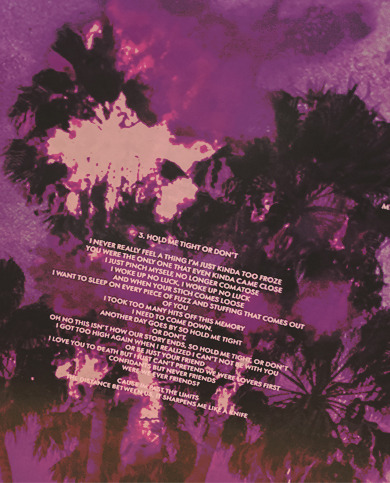
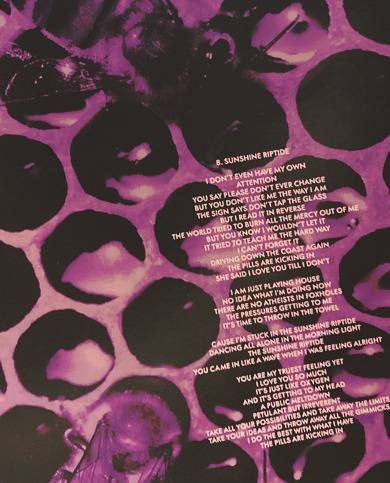

vinyls from my collection ( in no particular order ) 15 / darker colors
mania ( 2018 ) by fall out boy
#myvinyledits#vinyledit#fall out boy#falloutboyedit#bandedit#THIS ALBUM SLAPS AND YOU GUYS ARE JUST AFRAID OF CHANGE#like yeah i don't LOVE champion but are we going to ignore church??? heaven's gate??? last of the real ones???? hold me tight or don't????#bishop's knife trick????? sunshine riptide????????#I COULD GO ON!!!!!!!!!!!!!#also i personally love purple so this record was for me#def not a perfect album but it super didn't deserve it's canning#also i made the bold move of not including the front album art at all on this one so lololololololol#stan mania for healthy crops and good luck#REMEMBER THE FURSUIT LAWSUIT DUDE THAT WAS SO MUCH#can't believe fall out boy ripped off furries that was fucked up /gen#EDIT: I MEANT TO QUEUE THIS FUCK SHIT FUCK HECK DAMMIT
498 notes
·
View notes
Note
fashion queen! which nct era has the best fashun in ur opinion?? and if u were a designer which neos would u pick as ur models?
I was so excited to answer this that I wrote several pages and it basically turned into a style analysis for each unit so I sure hope you have some time on your hands to read everything I’ve just written! (I did not reread so sorry for any typing mistake)
NCT is known to be experimental in their music and that’s also the case in their styling so there’s a lot for me to get into even though sometimes it’s a miss. One thing I will say though is that when it comes to the styling in mv/teasers, what’s around the clothes is super important because if you have a very specific styling concept, your set design or graphic design needs to complement that and give the audience more clues on how to read all these elements together (the cherry bomb era is a great example of that with all the added graphic elements and the predominance of the colour pink) and recently I’ve found that the creative team has not really gone further than just putting nct in an outfit in front of a basic background so it makes for a pretty underwhelming result
But let’s move on to my favourite styling eras. I’m going to do this per unit (I’ll finish with NCT U) and define an era by its teaser pictures and the mv (and not go through all the performance looks during the promotion period)
I’m putting this under a read more because it’s reaaally long (I put pictures so that it’s not just one big chunk of text)
NCT 127
Easily the most experimental unit when it comes to fashion, especially in their first years where they would wear mix of sportswear, grunge references, avant-garde fashion and a lot of layers. When it comes to their debut “Firetruck”, I think it fitted the song really well but that it didn’t fit all the members equally (especially the younger ones, for me Taeyong and Taeil pulled it off the best – it’s expected of Taeyong but I also think that Taeil always stand out when they go for edgy/unconventional look, I think it really suits him).
Anyway, just to say that they were off to a very strong start and then I’m just going to kindly ignore the Limitless styling and move on to Cherry Bomb!
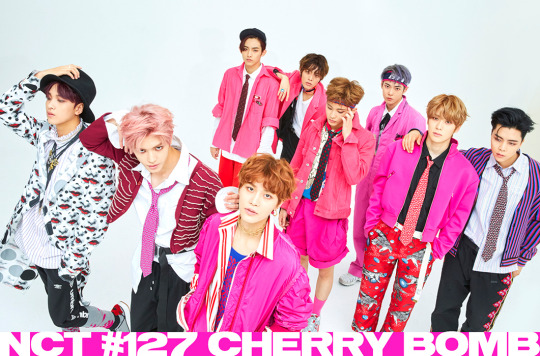
One thing nicely done for CB is how when you look at a group picture they’re clearly all following the same concept but they’re not necessarily matching or giving off the same vibes if you take them individually. I love the use of the colour pink which brings a) a great visual impact (you don’t ever see that much pink at once – especially on men) and b) an harmony despite the shapes and styles of their outfits being so vastly different, you’ve got ties, tousled, shirts, little frilled collars, stripes and all-over prints, sportswear and formal wear… (ex: taeyong’s short jacket is reminiscent of something a little luxurious, even maybe historical/noble with the little added embroidery-like details, it reminds me of these boleros jackets worn by toreros that are often red/gold VS doyoung’s overalls is an outfit that has a much more recent origin as it was first worn by factories workers, it’s usually blue or grey and is meant to be practical rather than pleasing to the eye -> here it fits very well with the general setting of the mv in what looks like an empty industrial storage space)
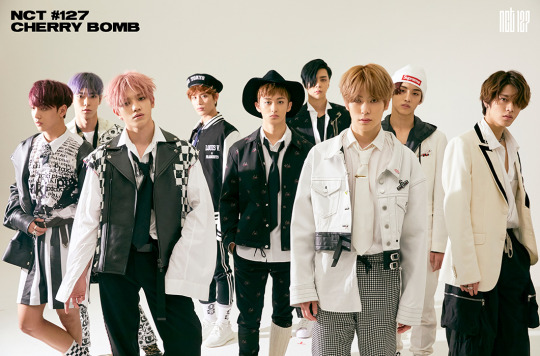
This second look is more of a game on how to deconstruct formal wear (there are less prints and no bold colours, their hair is less messy…) but they don’t just add sportswear like the bomber jacket, you can find rock or more “modern” elements with the leather jackets or the jean jackets. All in black and white so great contrast with the previous looks, although that mix and match concept is still there. My favourite elements are the checkered ones (worn by taeyong, taeil and haechan) as it reminds me of the strategy element of the chess game which fits pretty well with all the weapons and other arms visible in the mv (a bit like a nod to the game battleship)
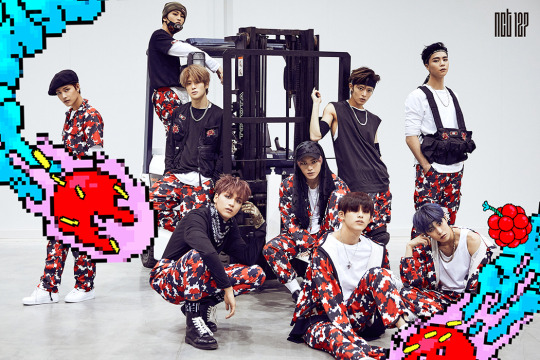
This one I love that they developed their own print, especially since it’s another graphic element used elsewhere (see their album cover), because it’s a great way to really introduce their identity as a group, through the different visual elements they put out in a comeback, it’s like a logo but as a print. And all the teasers and the mv did a great job at mixing 2D/3D contents so that’s another nice way to be cohesive. It’s not my fave look out of the 3 (especially because I do not approve of that belt-suspenders-bag they gave Johnny, it’s like everything you don’t want to put a dancer in and it’s ugly as well) but I still like the fact that’s it’s another nod to the battle/strategy aspect of this comeback, like they’re on a mission to hit the stage and conquer it
Then fast forward to my other favourite one, Simon Says! (No teaser pictures here because they don’t show anything or they show not enough lol)
First of all THE MASKS
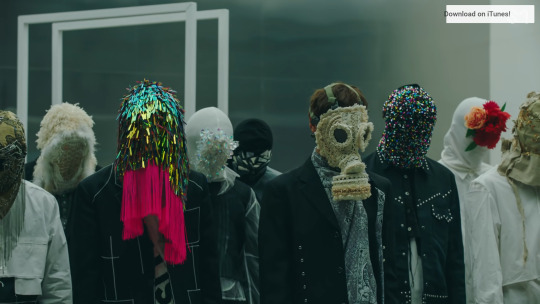
Oh how I wish they could’ve been shown more (imagine teasers with the members wearing them!!! I would’ve loved individual teasers based on each of the masks concepts) Once again, a great to have group concept without making everyone wear the same thing. They’re all super different and full of details. Haechan’s is the only one from what I could who’s mask is actually a mask and not a fully covering hood. The materials and techniques used on these are either evocative of “fragile” things like glass and flowers but theses elements have their own hidden strength. Some others are covered in lace, pearls, fringes or fur…all these things are usually considered to be precious or even luxurious but it covers their faces and their identity and they throw it away in rebellion (and I think it’s also super interesting how Taeyong who takes off his mask first has the least ornamented one)
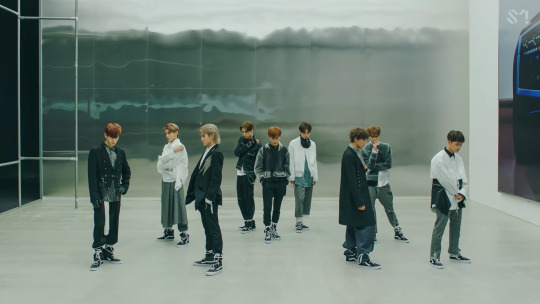
Then the outfits themselves. Simon Says in an interesting MV because unlike most others they wear one outfit for most of the MV (the second one appears quite late in the mv and is lit and staged in a way that makes it less visible). It’s a mostly grey/white set of outfits which is usually a colour combo for office wear or maybe factory workers, it’s not something that can seem very exciting or edgy. The styling in these outfits reminds me of the works of Japanese designers who came to Paris in the 80’s and kind of shook the whole high fashion system by bringing a different type of shapes, aesthetic and purpose to fashion (Rei Kawakubo, Yohji Yamamoto…). These designers went on to become super successful and inspired another wave of “avant-garde” designers nicknamed “the 6 of Anvers” (Anvers is a city in Belgium), this group includes Martin Margiella, Dries Van Noten…And to me the outfits in Simon Says really fit into this aesthetic. Unconventional fits, various layers, it’s not so much mix and match than a work on contrast between structure and fluidity (Yuta’s half skirt with un-trimed edges, Haechan’s long shirt with the long bow and the fitted jacket, Mark’s top with the various see-through layers of different lengths…).
An other interesting details (which to me calls back to the mask and that tension in the song/concept of letting go/being free of expectations), is the way they all have thick strings tied on their feet/ankles. Not holding them back because their feet aren’t tied together but there’s still this clear restriction of the garment itself, a reminder that there are tied to something and not completely free (also an interesting choice when dressing dancers who would need to have no added weight or discomfort in their outfit to dance but visually something is holding their ankles)
Honorable mentions:
Kick It– they managed to create very memorable outfits while taking inspirations from already well known elements (both for the fighting/training outfits and the bomber jackets). The black and white outfits especially are very original as performance outfits/dancing clothes since the og garment they’re inspired by has already such a strong identity outside of the performing arts and I don’t think I’ve ever seen it be used as a stage outfit? Or concept? It’s a nice exemple of how you can take inspiration for something designed to be useful and to be efficient (in fighting) and turn it into an aesthetic.

Truthfully, martial art training outfit was already an “aesthetic” on its own but they made it a performance costume and now I do feel like it’s one of these looks that everyone will remember (like if there was a “most memorable kpop outfits” list it could easily have kick it’s black/white fits). The rest of the outfits for that concept weren’t as memorable/original to me although I feel like it showed a new approach to the styling of nct 127 as a group since they all had very similar outfits this time (especially when wearing the jackets).

Also, interestingly, that shot of Jaehyun that had everyone go “wow” ? Well it’s impactful because it’s him and he looks like that and it’s shot in a very specific way, but it’s also even more impactful because he’s the only one who gets to wear that kind of outfit in the mv. Everyone else has 3 sets of outfits (black and white, shiny black, red jacket and black pants) but he has 4 and that suit is only used in that shot which makes for a greater impact!
And I feel like Kick It in terms of styling opened a new era for NCT 127 has it kind of broke their usual mix and match/edgy concept. This time they were clearly referencing something already well known (either martial arts, the 90s…), and the members were all matching and they kept on doing that with the military jackets in punch, the other 90s concept in nct 2020…
Touch – for the way the outfits match the sets (in all their individual sets their outfits have a detail in a matching colour), the focus on colours !!! You can see that this whole concept was designed with this colour game/colour progression between the outfits and the set in mind. It’s just very pleasing to the eyes and a great contrast to their usual stuffs (also I wrote my graduation paper on colours so I am really into creative use of colours like this)
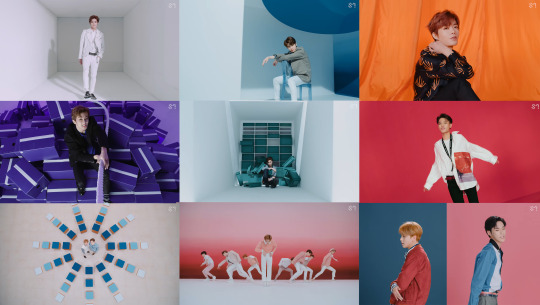
OK now moving on to Dream!!
The interesting thing about Dream compared to NCT 127 is that from the beginning although their outfits had to match the song an the concept of the comeback it also had to match their age. Dream’s a group that had to look young when debuting (to the point where they wore outfits that made them look even younger than they were which is rarely done for boy groups) and then they had to transition into adulthood, and all of that had to be made visible. In that aspect, I really like the styling for We Young and Boom (especially when you look at them at the same time).
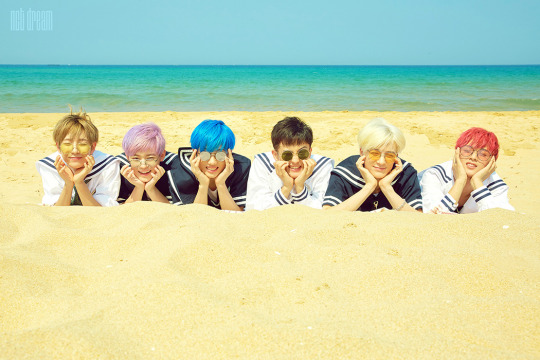
For We Young, the styling is meant to be reminiscent of school/boy scout uniforms but with a marine vibe. It makes for playful outfits that aren’t too childish but that also aren’t grown up. I prefer the “seaside” outfits as I don’t really like school uniforms as a concept for styling and I think it’s really a choice that suited them and the song so well, it really fitted their energy. It’s playful but it also has a vintage touch to it as these outfits with their stripes and their squared flap at the back date back to the XIXth century (I just found out that it all started with the queen Victoria dressing up her kid in an outfit inspired by the royal navy uniforms for a painting after a cruise ).
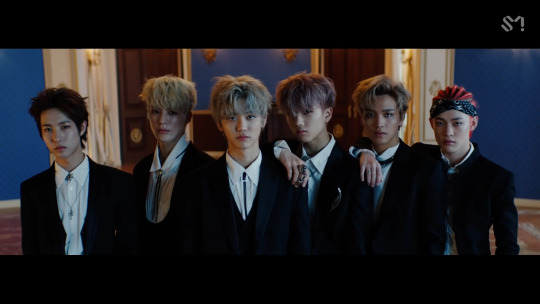
Boom on the other side is their first proper “grown-up” concept. We go up was already more grown up but still very “teenager-ish” and although they were mostly teenagers when they did Boom it was clear that this was supposed to be their first entry into “adulthood” as a group at least. And although they did wear a sportswear/casual outfits which is something that isn’t related to age (and I really like the black and white “skeleton” set which already feels more grown-up and more “stylish” than the other casual outfit) , they wore two other “grown-up” elements: suits and all-jean outfits.
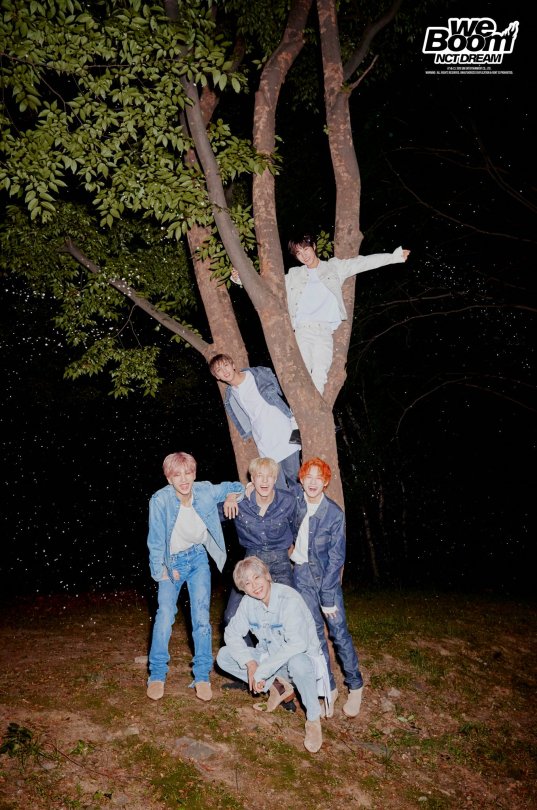
And yeah teenagers, and kids wear jeans too but a full jean-on-jean outfit is more of a “grown-up” fashion choice and it makes them look like young men rather than boys. As for the suits, I just really love when stylists play with the codes of that garment (length of the jacket, tightness of the pants, the way the shirt is tucked in…).
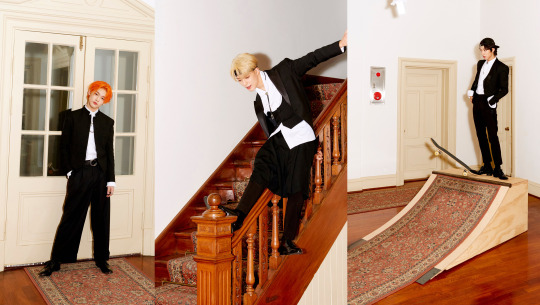
Notice how Renjun has a really short jacket, Chenle’s pants are wide, Jeno has a tail…Once again, a really interesting aspect of Kpop is the variations of the same concept based on the members. In the mv, there is a tension between their more grown up selves (the one in suits, the one with a craft/a path) and their young selves (the one running around in the field, the one laying down in the flowers and eating a cake). And there is also in these outfits and the contrast between them this tension, this contrast…which path should they go? The jeans are the more laide back, innocent outfits, whereas the suits come with responsibilities and status (and you’ll notice that in the scene where jisung is left alone to blow his candle it’s when he’s wearing jeans not when he’s in the suits).
Now on to WayV!!
WayV are different from the two in the sense than when they debuted they couldn’t have an “age” concept or an edgy concept because 127 and dream had already taken those and I feel like for that reason they’re still looking for what makes them stand out visually from the others (and in my opinion it’s not in whatever they were wearing for turn back time!). WayV’s concept is space and time travel, it’s building a new life, a new worl, going beyond anything! In my mind, they’re either supposed to feel a bit “otherworldly” (either spectacular or literally like they’re from another world/another universe, a little bit futuristic maybe?) or to look like explorers/travellers (they have a lot of travel/transportation “gears” references in their outfits). Their MVs also have a very different production than the other nct mvs (the scale and the way it’s filmed, the sets…it’s a different approach and it’s usually much more “grand” for their title tracks). The great thing about WayvV styling is usually that they match the outfits well with the world that the mv is set in (like in Moonwalk for example you get a sense of the world they’re in and the fact that it’s not ours or at least not as we know it now through the way they dress – you can’t really say oh it’s inspired by this era or by this or that because -at least- to me it immediately gives me a vibe of something that could be worn in a sci-fi movie, almost like a costume) or that they allude to travel in their styling.
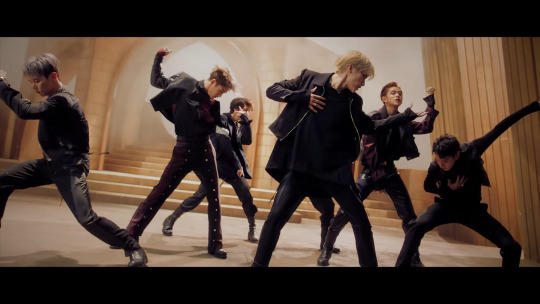
When they debuted with Regular they went for a very sleek and high fashion look which worked really well for them! Even their more “casual” looks were a bit striking and I think that’s very “wayv-like” to me.

Same goes for Take Off where they mix the individual styles (and I don’t like ten’s leopard fur sleeveless jacket at all) and the group concepts – the “flying” outfits and the “racing” outfits (that last one is my favourite! I love the silhouette it creates with the tight pants and the larger tops with an emphasis on the waist).

There’s something a bit extra to WayV - which is why some of their outfits remind me of costumes more than fashion while at the same time they’re the most “high fashion” unit– like the “flying” outfit in Take Off are recognizable as “flying gear” but you can’t really tell what they’re flying, it feels once again like something that they could wear in like star wars or a similar kind of story.
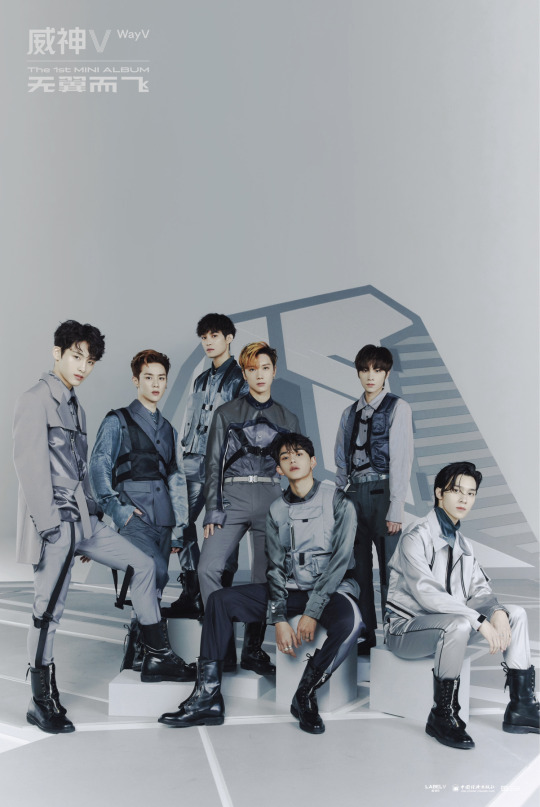
Imagine a movie about 7 men on another planet trying to come together to overcome the dark forces or whatever’s bad on their planet in a futuristic society with a mix of “traditional” and “trendy” outfits? That’s WayV. The movie the 5th Sense? That’s WayV but on steroids. They’re also the only group with actual characters in their mvs, they’re all supposed to have a backstory or an individual setting and find a way to get together in their mvs.
Anyway all that to say that it’s hard for me to pick an era for them because they’ve only had a few and they still feel like they’re looking to solidify their concept, and since moonwalk and turn back time really set the styling in different worlds than ours, you have to look at how they fit in that world rather than ours and I think Moonwalk does it best since it’s the most cohesive one visually. But then I think Regular had the best individual styling!
Okay this is super long but we’re finally getting to NCT U!!!!
Number one favourite:

The Year Party outfits!!!! I’ve already talked about this but I love when they say we’ll put them in suits and then since they have to make a different one for each of them they cut bits an dpieces of the suits here and there, play with lengths. It’s not a revolutionary concept but in terms of searching for a shape, searching for variations of an already so famous, so well-known garment (everyone has seen a suit, and so many designers have already deconstructed it and then put it back together and so on) it’s so nice, it’s almost like a full collection given how many members there are and it’s just a good tailoring work.It almost feel like an exercise of how many variations of an outfit can you think of? And it looks fun to do! It’s all about the details and the way the layers are set together.
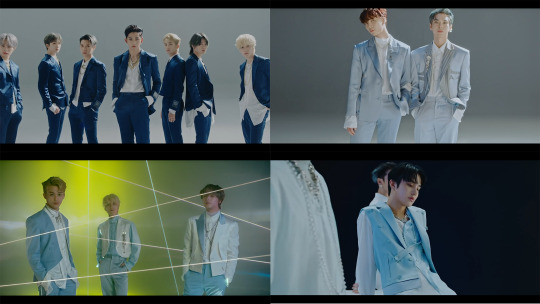
The accessories add to the “formal attire” aspect of it. It almost has a ceremonial look to it. A bit of royalty with the futuristic vibe usually associated with WayV. The dark blue suits were pretty classic, the most interesting details (for me at least) were on the light blue ones. Especially since it’s a rare colour to find in formal wear or in ceremonial wear. In general, I feel like it’s a pretty rare colour in fashion outside of like shirts and baby clothes? I think it was a great styling choice for a content like the year party although I do wish they (either NCT or WayV who’ve touched upon this kind of outfit a bit already) would do a full comeback with this kind of styling (like the lighter version of the black and green outfits in SuperM’s One). It’s not revolutionary but it was something new for NCT and I really hope they use that elegant/futuristic concept once again.
Also in these outfits, the jewelry is super important and adds to the “grand” aspect of these outfits. The concept is that these aren’t ordinary outfits for ordinary men, we’re witnessing something “special” and so they aren’t wearing their usual jewels either (of course the big chains are still there but differently look at that necklace jaehyun is wearing)

Honorable mention:
Boss & Baby Don’t Stop (they’re different but they go together in my mind lol). Look at them in their uniforms! And also they had doyoung wearing these sunglasses
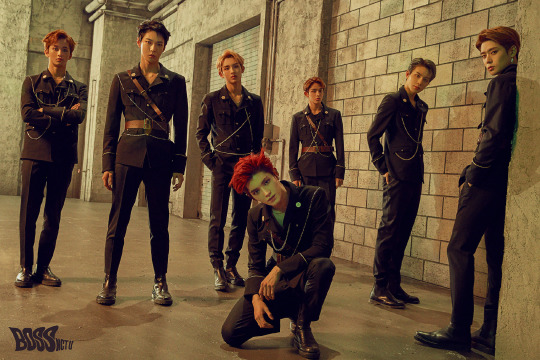
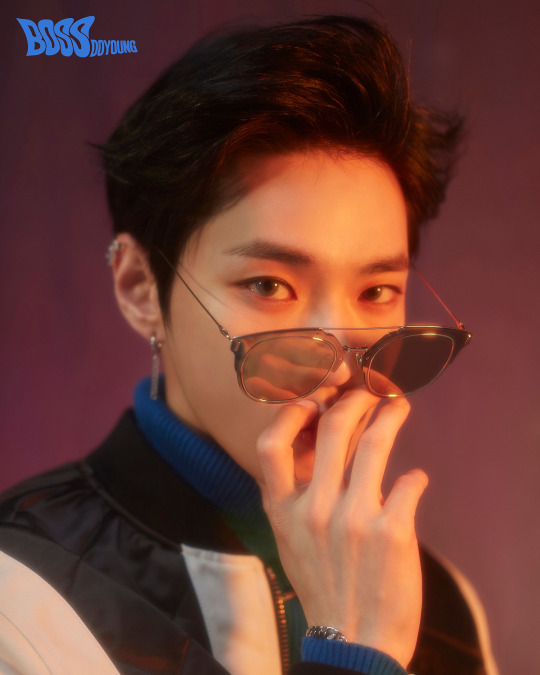
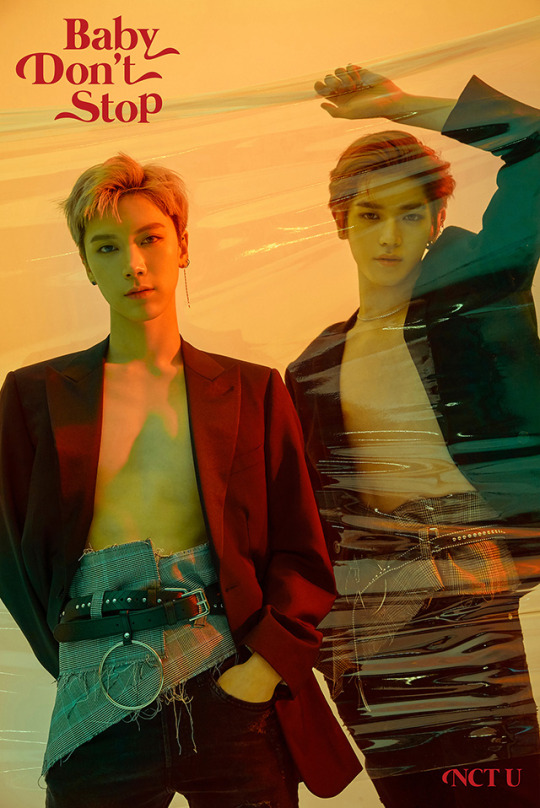
Ok I think I’m done, if you’ve made it this far thank you so much and I hope it was a nice read!!
As for who would I chose as my models…it really depends on what I’d make them wear tbh for menswear the things I’d like to design would either be something like formal wear or knitwear – I’d pick Lucas, Taeyong and Doyoung (I think they’re the most model-like members and could pull off pretty much anything even my non-edgy concept because I can’t do that lol and they pose very well) and then depending on the concept I’d pick between Winwin, Jaehyun, Kun, Jungwoo, Taeil, Haechan and Shotaro (the way I struggled to remember all the members at once…there are too many really)
#this is soooo long omg I didn't know I had that much to say wow#I hope you've managed to read it all and that it was somewhat coherent and clear#now it's time to eat#nct#nct 127#nct dream#wayv#nct 2020#fashion#leemarx#I've got mail#vinformation
34 notes
·
View notes
Text
Love’s a game, wanna play? A meta-analysis of the game of love and Taylor’s love of games
—
Before actually getting into this, I’m obligated to make the disclaimer that this is just my interpretation of some songs. I’m not claiming to be “right” about anything. I have no way of knowing whether my observations will hold true if/when Taylor releases more music. It doesn’t really matter. There are many ways to interpret music.
Games are not the only extended metaphor in her discography; if you understand one, you don’t necessarily understand them all. This essay is an exploration of how one particular metaphor could be so effective.
In addition, I am often the first person to say that “not everything is that deep.” Yet here I am, making something deep. I was only mildly curious about this metaphor at first. In the process of documenting my understanding, I surprised even myself as I realized how rich this metaphor is.
A warning…this essay is very long. (It’s either mildly interesting or completely ridiculous and nothing in between. Likely the second.)
—
The notion of a ‘game’ is often conflated with the notion of adversarial conflict. This misunderstanding is largely due to Western structural/cultural forces. Mathematicians and economists have a passion for framing most predicaments as zero-sum, or strictly competitive, where one player’s advantageous move by definition disadvantages their opponent. But collaborative and otherwise not strictly competitive games exist too.
Taylor’s fascination with games spans her entire discography. Artistic preoccupation is reason alone to analyze her work from such an acute angle. But pleasantly, Taylor also does not share the academics’ favorite pastime. She strays away from the zero-sum bias in very unpredictable ways. In fact, she has no bias. She prefers to mix and match her language to each situation as she sees fit. Her convolution of love and games is expressive, divorced from the logical framework by which games are defined. I think examining this facet of her work with a fine-toothed comb may be especially illuminating.
It seems counterintuitive to argue that games could (or should) be anything more than Taylor’s favorite metaphorical manifestation of logos. Yet revisiting a metaphor is itself communication, conscious or not. Advancing an understanding of this extended metaphor, in my opinion, substantiates what is usually intangible about Taylor’s songwriting brilliance.
On Games
Precocious and perceptive, Taylor has, for as long as she’s been writing, placed competition, strategy, and collaboration alongside conflict. Therefore, for the sake of coherence and relative brevity, analysis is scoped only to songs with significant mentions of games, puzzles, or game-related imagery. ‘Games’ are not conflated with general fighting, trickery, toying, revenge, mention of rules/strategizing, or winning/losing. ‘Puzzles’ are not conflated with disorder; puzzle pieces must be pieces of a larger, vivid picture.
Consider football. Imagery of high school football makes “Miss Americana & The Heartbreak Prince” fair territory. Someone shouting over a football game in a bar does not qualify “Mean.” The football helmet worn in “Stay Stay Stay” is an absurd and compelling detail in context, as likely to be fictitious as it is true, and hence more significant than a televised sporting event; “Stay Stay Stay” qualifies. In essence, games are interesting as a device rather than a simple detail.
Below is a list of the songs with significant game reference(s), categorized by implied type. Note that a song can belong to multiple categories if it contains multiple references.
Generic/unspecified games: “Come in With the Rain”, “Dear John”, “State of Grace”, “Blank Space”, “Wonderland”, “…Ready For It?”, “End Game”, “Look What You Made Me Do”
Card games: “New Romantics”, “End Game”, “Cornelia Street”, “It’s Nice To Have A Friend”
Dice games: “Cruel Summer”, “Miss Americana & The Heartbreak Prince”
Board games: “Dear John”
Sports/contests: “The Story Of Us”, “Long Live”, “Stay Stay Stay”, “End Game”, “Miss Americana & The Heartbreak Prince”
Puzzles: “Red”, “All Too Well”, “So It Goes…”
Other: “It’s Nice To Have A Friend”
Like many people, Taylor habitually seeks structure to manage unpredictability. (Games provide structure for situational volatility, hence her artistic love affair with this metaphor.) The stylistic choices she makes to entertain this habit, however, are anything but consistent.
The games have a variety of different players, such as in “Dear John” and “Look What You Made Me Do.”
She does not establish strict parity between characters’ emotional affiliation and the competitiveness of a game. “Dear John” features an adversarial game. Conversely, her partner in “Blank Space” is a co-conspirator/collaborator. “All Too Well” analogizes autumn leaves as puzzle pieces; puzzles are collaborative games.
Taylor famously claims that love is a game in “Blank Space.” This song is colloquially understood to be about the love story we see play out in the media. Games can thus include all parts of her ‘love life.’ Arguably, she foreshadows this in “Long Live” by intertwining parts of her ‘America’s sweetheart’ image with professional success, which is derived from writing about love.
Taylor is not always a player in a game, such as in “Cruel Summer.” Her partner may not be either; see the crossword in “Red.”
In short, humans are unpredictable, as is love. It is clear that Taylor uses games as an incredibly powerful metaphorical device. They are a genuine reflection of her feelings about love.
Musical analysis usually begins with careful consideration of each track. Given a disparate and lengthy list of songs, it is probably more fruitful to go up a layer of abstraction. Of particular intrigue for this set of songs is the relationship between time and Taylor’s willingness to divulge more information about a metaphorical game.
We revisit the set of songs to list them in chronological order. The purely ‘generic’ songs are now bolded: “Come in With the Rain”, “Dear John”, “The Story Of Us”, “Long Live”, “State of Grace”, “Red”, “All Too Well”, “Stay Stay Stay”, “Blank Space”, “Wonderland”, “New Romantics”, ”…Ready For It?”, “End Game”, “Look What You Made Me Do”, “So It Goes…”, “Cruel Summer”, “Miss Americana & The Heartbreak Prince”, “Cornelia Street”, “It’s Nice To Have A Friend”
Specificity about a game seems to decrease with proximity to the 1989 era.
Lyrical imprecision in “Come in With the Rain,” a true outlier, probably boils down to youth.
“State of Grace” is a preamble about the themes of Red. “Begin Again,” though much later on that album, shares the same inspiration as “State of Grace.” Red is constructed as a sandwich between these two songs which present the album’s thesis. The album considered as a whole is thus a buffer for 1989.
reputation is a buffer for 1989 because the ‘generic’ game songs are heavily and intentionally front-loaded.
“New Romantics” is a coda for 1989, and its poker game reference is slightly ambiguous. What, exactly, is poker; what is all in the timing? The thematic material of “New Romantics” is most similar to that of “Blank Space.” ‘It’ is the same crude game played in the earlier track, the affair of collecting men. Perhaps this close relation subsumes “New Romantics” under the ‘generic’ game category. (Though this is a loose explanation.)
There exists an undeniable chronological pattern to game characterization. If you graphed the amount of game-related lyrical obscurity versus time, it would look like a shallow sand dune with the tip at the 1989 era. (Or a hill. Or a big pile of leaves. You get the picture.)
Armed with a basic understanding of Taylor’s career, one might say that her desire for personal privacy manifests as reticence to define metaphorical games. The 1989 era was the height of media attention on her. This caused more than a few issues. The art created around this time would have naturally reflected how she felt about the public eye. (See: the entire reputation era.)
But isn’t Taylor almost as famous as ever today? Sure, her name is not as saturated in the zeitgeist as it was in 2014. She’s still one of the world’s mega-stars. And does she not have a very private relationship today? Taylor’s work reflects her hardened personal boundaries, but boundaries alone do not explain the pattern of how she writes about games. Otherwise Lover would be filled to the brim with songs about ‘generic’ games.
To summarize, Taylor uses games as a perennial favorite metaphor to frame her experiences of love. Increased public scrutiny undoubtedly changed the way that Taylor approached songwriting; even so, fame was not a factor that changed how she wrote about games. The connection between time and types of games suggests that we cannot consider game metaphors in isolation.
On Love
The next piece of the puzzle (no pun intended) is what she shares about love. Which 1989 songs are most revealing? Technically…most of them, if you think hard enough. I’d like to draw special attention to “Wonderland” and “You Are in Love.”
Ah, “You Are in Love.” The musical gift that keeps on giving! Fitting, because true love should be too.
In “Wonderland,” Taylor says:
It’s all fun and games ’til somebody loses their mind
Shortly thereafter in the “You Are in Love” bridge, she proclaims:
You understand now why they lost their mind and fought the wars
And why I’ve spent my whole life trying to put it into words
Taylor reverses her opinion about the prospect of losing her mind for love. (The abruptness here is a consequence of a real-life relationship change, plus the fact that both of these songs are bonus tracks.) Of course, she also tells us an important connection between love and games.
I’ll pause here to say that I’m not going to turn this into a (frankly uninteresting) relationship timeline/proof post. But may the profound significance of “You Are in Love” and its subject never escape us.
“You Are in Love” is written in the second person. Taylor is the intensely guarded ‘you.’ We witness her emotional walls get broken down by her lover, the ‘he.’ Fascinatingly, Taylor departs from the second person point of view in the bridge. Suddenly, she alerts us to the presence of an ‘I.’ The bridge says that ‘you’ Taylor, whole and normal-person-in-a-relationship Taylor, finally understands true love. In the same breath, ‘I,�� writer Taylor, admits that she’s had it all wrong for years. (This is not to say that her writing pursuits before this moment were pointless.) Therefore, breaking the second person point of view to include the ‘I’ line shows that Taylor distills the nature of true love in that ‘eureka’ moment.
Yet she exposes the schism of writer Taylor and whole, normal person Taylor in a moment where, in theory, those two roles could not overlap more. Taylor has every reason to faithfully represent her feelings. Her sentiment is always sincere even though she may falsify details of a story. “You Are in Love” is (as far as I’m aware) the only song in which Taylor ever blatantly admits to writer-person misalignment. The schism must run extremely deep.
Taylor was—and surely still is—drawn to songwriting as a means to explore love. She tries to to capture its enigmatic essence with the written word. How fascinating it is that, at the very moment she communicates her deepest understanding of love, she says that the part of her that puts it into words is inherently disconnected from her spirit which feels it.
On Games And Love
We must briefly table the meta-implications of “You Are in Love” to return to the topic of games.
Love probably would have stopped feeling like a game after finding a real gem of a person who doesn’t mess with your head. (Love also probably would have stopped feeling like a game after dialing down on brazen PR tomfoolery.) Taylor has written several albums about her true love. It’s easier now to trace the arc of her feelings: it is a positive path, as anyone would predict.
Why would she continue to write about games after 1989? The obvious answer is that she likes doing it. It remains a useful metaphor.
But recall that chronology discourages us from considering metaphorical games in isolation. To clarify the principal function of the game metaphor in her discography, we must consider the writer-person dichotomy.
First, note that Taylor exposes the writer-person dichotomy in an honest, vulnerable moment. She confirms it as a human phenomenon. The phenomenon thus must extend beyond a singular moment during 1989. Distance between writer Taylor and whole, normal person Taylor—a measure henceforth called writer-person distance—is necessarily a function of time. Coincidentally, so is the measure of game-related lyrical obscurity.
Writer-person distance can grow or shrink. It was small in her youth; this is what pushed her into songwriting. It is small now, as she has told us in the albums since 1989 that true love has stitched her back together. Again, because writer-person distance is a human phenomenon, it changes slowly, smoothly. (“You Are in Love” simply marks the biggest distance.) Does this sound familiar? If you graphed writer-person distance versus time, the graph would look like a shallow sand dune with the tip at the 1989 era. (Or a hill. Or a big pile of leaves. Once again, you get the picture.)
To summarize, game-related lyrical obscurity and writer-person distance are smooth functions. “You Are in Love” is the inflection point of both measures.
With “Wonderland” and “You Are in Love,” Taylor tells us that games are linked to how she conceptualizes love. But not just any love. 🎶 True love. 🎶
At the same time, Taylor presents “You Are in Love” as a dividing line between ‘that which is a best attempt to understand something that inherently cannot be captured’ and ‘that which refines the thing that, against all odds, was captured.’ Our interpretation of games must synthesize an abrupt ‘eureka’ moment with both the measures’ gradual changes.
If we are to talk about metaphorical games, we also must talk about true love. But we know that if we are to talk about games, we also must talk about time. Vital to uniting these ideas is the revelation that Taylor conceptualizes the nature of true love as the nature of time. For doesn’t time define what is gradual and abrupt?
The most important line in “You Are in Love” is when Taylor finds it—‘it’ being love. A literal ‘eureka’ moment. This isn’t just a one-time coincidence.
Writer-person bifurcation clarifies why the game metaphor is surprisingly effective. As Taylor revisits the convolution of love and games, the metaphor morphs in tandem with her innate understanding of love.
Some Good Old-fashioned Song Analysis
Observing how games, love, and time are intertwined requires that we reject purely literal interpretations of game-related lyrics after “You Are in Love.” Of course, literal interpretations are still generally useful, even correct. Games are literal, so references to them should be interpreted as such. Also, lyrics about games are probably Not This Deep in reality. We didn’t have to do all this work to realize what songs might belong in conversation with each other; identifying lyrical callbacks would have been sufficient. Treating game lyrics as purely literal limits how we might decipher a recurring metaphor. Without the notions of game specificity or writer-person distance, we would lack a framework with which to fully interrogate how these songs are are connected (i.e. through time). And, after all, the ultimate goal is to understand why the game metaphor is so successful. But, I digress.
(We’ve also made it this far and we might as well keep going. Another couple thousand words…don’t threaten me with a good time, amirite?)
To observe how games, love, and time are intertwined, I propose the following rule of thumb: A game reference before “You Are in Love” is Taylor’s description of love, whereas a game reference afterwards is a pointer to past instances of that game. Such a reference is metaphysical, or more appropriately, meta-lyrical. If she’s referenced a game already, she knows how to use that reference again. If she introduces a new reference, she’s planting it for future use.
We can group the songs after “You Are in Love” by game type:
Generic/unspecified games: “…Ready For It?”, “End Game”, “Look What You Made Me Do”
Dice games: “Cruel Summer”, “Miss Americana & The Heartbreak Prince”
Card games: “New Romantics”, “End Game”, “Cornelia Street”, “It’s Nice To Have A Friend”
Sports/contests: “End Game”, “Miss Americana & The Heartbreak Prince”
Puzzles: “So It Goes…”
Other: “It’s Nice To Have A Friend"
Analysis requires precision. We should pare down the duplicates, if possible.
“It’s Nice To Have A Friend” is tricky because it’s naturally sparse. “Video games,” for example, are more than a simple detail: they are an essential part of creating a childhood vignette. “Twenty questions” and the card game “bluff” function analogously in the later verses. The brilliance of this song lies in how Taylor illustrates the development of companionship and intimacy. The verse about marriage is the most significant verse because it reveals the meaning of the whole song. Thus, we may take the bluff to be more important than twenty questions, which is more important than video games. “It’s Nice To Have A Friend” ultimately belongs in the card game category.
Central to the pathos of “Miss Americana & The Heartbreak Prince” is the “stupid” dice game lyric. Of equal importance is the portrait of Americana, painted with lyrics about Friday night lights. This song truly belongs in two categories.
At the end of “…Ready For It?” Taylor fires a starting pistol, letting ‘generic’ games begin. “End Game” follows and we assume it must pertain to the same game. So Taylor intentionally places this song in the first category. The hook has lyrics about a varsity “A-team,” though this is probably just a nod to Ed Sheeran. The other truly interesting game-related lyric is the one about bluffing. Thus, “End Game” also belongs in the card game category.
Here’s the new list:
Generic/unspecified games: “…Ready For It?”, “End Game”, “Look What You Made Me Do”
Dice games: “Cruel Summer”, “Miss Americana & The Heartbreak Prince”
Card games: “New Romantics”, “End Game”, “Cornelia Street”, “It’s Nice To Have A Friend”
Sports/contests: “Miss Americana & The Heartbreak Prince”
Puzzles: “So It Goes…”
Each of the four obvious groups of songs illustrate a different way Taylor weaves the natures of true love and time together:
Déjà vu: “So It Goes…”
Hindsight/wisdom: “…Ready For It?”, “End Game”, “Look What You Made Me Do”
Fate: “Cruel Summer”, “Miss Americana & The Heartbreak Prince”
Progress: “New Romantics”, “End Game”, “Cornelia Street”, “It’s Nice To Have A Friend”
Déjà vu
The puzzles category only contains one song, making it easiest to analyze. The namesake of “So It Goes…” is Kurt Vonnegut’s Slaughterhouse Five, famously constructed like a mosaic. Puzzles are central to the meaning of this song.
“All Too Well” contains the first instance of a puzzle metaphor in her discography:
Autumn leaves falling down like pieces into place
Taylor calls back to “All Too Well” in the chorus of “So It Goes…”
And our pieces fall
Right into place
Get caught up in the moment
Lipstick on your face
By referencing a previous song using identical phrasing, Taylor creates the illusion of a sudden ‘déjà vu’ moment. The effect is similar to “You Are in Love,” where she reaches sudden enlightenment.
Sonically and lyrically, the “moment” she gets caught up in is implied to be the one in which she gets lost in passionate sex. The déjà vu moment could be this moment, but it doesn’t have to be. Déjà vu is agnostic to the present in the sense that the feeling can be triggered in the strangest of times. The déjà vu moment is whatever prompted her to write this song.
This game lyric connection clearly shows how a moment of love is defined by a moment of time.
Hindsight/Wisdom
The bombastic group of singles, “…Ready For It?”, “End Game,” and “Look What You Made Me Do,” sets the tone for all of reputation. The ‘generic’ games in these songs are the same as those in 1989, particularly the crude (and, in Taylor’s case, often interchangeable) games of celebrity and dating. In “Blank Space,” Taylor spells out in gory detail what she does as an agent in the celebrity dating game. She does not explicitly define the rules of that game, though. It remains sufficient for her to prove that she knows how to play by them. (Musically, this is far more interesting.)
We know that the reputation singles’ literal proximity to 1989 indicates Taylor’s direct emotional response the previous era. The consequences of a ‘fall from grace’ underpin the entire reputation era. Therefore, Taylor uses lyrical connections from reputation back to 1989 to illustrate hindsight. She tells us what she learned from her mistakes and what she wished she would have done differently.
But first, she gets to be salty about it. In “Look What You Made Me Do,” Taylor laments the fact that she participates in public games to appease others. (Because, really, withdrawing from the celebrity circus would immediately solve a lot of her problems. Alas, megastardom is a Venus flytrap.)
I don't like your little games
Don't like your tilted stage
The role you made me play
Of the fool, no, I don't like you
Let’s return to “Blank Space” for a moment. Taylor’s boyfriend in “Blank Space” is considered a co-conspirator/collaborator with her in the celebrity dating game. Central to our understanding of that song, however, is the unequal power dynamic. Taylor is the strategic mastermind, whereas her boyfriend is just along for the ride. The two are on the same team, but they are not equals.
Taylor actually leans further into the games of the 1989 era in “…Ready For It?”
Baby, let the games begin
Unlike in 1989, her partner is an equal on her team:
Me, I was a robber first time that he saw me
Stealing hearts and running off and never saying sorry
But if I'm a thief, then he can join the heist
And we'll move to an island
She then connects “…Ready For It?” to “End Game”
Baby, let the games begin
Are you ready for it?
//
I wanna be your end game
Both Taylor and her partner are forced to play the same game and they share share the same goal. Her partner’s “end game” is Taylor; thus, Taylor keeps her true love by beating the celebrity dating game. They have to work together to achieve this difficult task.
Though the celebrity dating game is not true love, it impacts Taylor’s relationship with anyone who could be her true love. In hindsight, Taylor realizes how media games blew up in her face. It is wisdom—to keep her relationship private, to dial down on PR tomfoolery, to prioritize her happiness—that helps her pre-empt these problems for the reputation era. And indeed we understand the love story of reputation as the lovers’ prolonged attempt to hide from the public eye.
Hindsight comes with the natural passage of time. One only accrues wisdom, however, when they apply the lessons of hindsight to make better judgements about the future. Games again unite the ideas of love and time; they elucidate how Taylor uses wisdom to protect someone she loves.
Fate
“Cruel Summer” and “Miss Americana & The Heartbreak Prince” highlight the elegance of the meta-rule of thumb.
The dice game in “Cruel Summer” is a unique incarnation of the game metaphor because Taylor doesn’t confirm whether she is directly involved in this game:
Devils roll the dice
Angels roll their eyes
What doesn’t kill me makes me want you more // And if I bleed you’ll be the last to know
The song doesn’t reveal much about the nature of the dice game other than the fact that it is competitive. It could be a fitting description of what is going on in Taylor’s personal life. It may not be. What is more important is that Taylor positions herself as collateral damage of the outcome of the game.
This is also the dice game’s first appearance. By our rule of thumb, this lyric exists only to be a link to “Miss Americana & The Heartbreak Prince.”
“Miss Americana & The Heartbreak Prince” belongs to two different game categories, sports/contests and dice games.
First, dice games. We get a few more answers about the nature of the “Cruel Summer” competition:
It's you and me
That's my whole world
They whisper in the hallway, "she's a bad, bad girl"
The whole school is rolling fake dice
You play stupid games, you win stupid prizes
It's you and me
There's nothing like this
Miss Americana and The Heartbreak Prince
We're so sad, we paint the town blue
Voted most likely to run away with you
Both Taylor and her partner are forced to play the dice game by virtue of being metaphorical students. As a disgraced and about-to-be-vagrant prom queen, Taylor has finally realized that winning the school’s dice game is not worth the price of a ‘fall from grace.’
Next, sports/contests. With the understanding of these lyrics as pointers to her previous songs, sports/contests harkens back to “The Story of Us,” “Long Live,” and “Stay Stay Stay.”
“The Story Of Us” suggests that a shared quality of sports/contest metaphors is that conflict is nuanced, even hidden to outsiders:
This is looking like a contest
Of who can act like they care less
In “Stay Stay Stay,” football is connected to (for lack of a better word) violence, conflict that could result in emotional and physical harm:
I'm pretty sure we almost broke up last night
I threw my phone across the room at you
I was expecting some dramatic turn away
But you stayed
This morning I said we should talk about it
'Cause I read you should never leave a fight unresolved
That's when you came in wearing a football helmet
And said, "Okay, let's talk"
Finally, “Long Live” blends the ideas of small town Americana with Taylor’s personal and professional life:
I said remember this moment
In the back of my mind
The time we stood with our shaking hands
The crowds in stands went wild
//
I said remember this feeling
I passed the pictures around
Of all the years that we stood there on the sidelines
Wishing for right now
We are the kings and the queens
You traded your baseball cap for a crown
When they gave us our trophies
And we held them up for our town
And the cynics were outraged
Screaming, "this is absurd"
'Cause for a moment a band of thieves in ripped up jeans
Got to rule the world
The backdrop of “Miss Americana & The Heartbreak Prince” is not just any part of America. The juxtaposition of idyllic parts of American life with frictional, violent, yet sometimes subtle forces tells us that the song’s backdrop is an American culture war. It is conflict which unsettles everyone, but by nature hurts only some.
In totality, the function of the dice game metaphor is to position Taylor as collateral damage of an American culture war. (Chew on that one for a bit.)
Again, we probably could have surmised this by examining the lyrics closely. The song lends itself to being a signpost in the Lover chronology. It seems too autobiographical to be anything different. We all remember 2016.
However, “Miss Americana & The Heartbreak Prince” sticks out like a sore thumb from the album’s theme of “a love letter to love itself.” Revisiting games as a glue between love and time expands on the purpose of “Miss Americana & The Heartbreak Prince” in Lover.
The “Cruel Summer” bridge contains this lyric understood to be about her true love:
And I snuck in through the garden gate
Every night that summer just to seal my fate
Taylor identifies “that summer” in the 1989 era as the moment which she sealed her fate. Implicit in this confirmation is her perspective from the future. She is looking back on 1989 from the time when her terrible fate has just been realized.
The moment of realization is—you guessed it—the chorus of “Miss Americana & The Heartbreak Prince.” The chorus depicts post-prom queen defamation. Taylor is aware of every single action (many, probably deliberate) that helped her achieve royalty. She never divulges them. The song is scoped only to the time when she lives her fate.
We usually take observations about fate and love to describe how two souls are bound to each other. Taylor does not tell us much about her lover in “Cruel Summer” sans the fact that the shape of their body is new. Paying special attention to games reframes “Miss Americana & The Heartbreak Prince” within the Lover theme as a commentary on fate. However, the emphasis of fate should not be on her lover. The dice game connection tells us that Taylor views “that summer” in the 1989 era as the time when she sealed her fate as collateral damage in the American culture war. From the “love letter to love itself” perspective, the moral is that passion and excitement can make lovers forget the immutability of individual destiny. If you are fated to be with someone, both of you are at the mercy of whatever the world has in store for the partnership and you as individuals.
Progress
An eclectic group of songs shares a reference to bluffing in a card game. The game metaphor beautifully stitches these songs together into parts of the same story.
The first and most detailed description of the card game is in “New Romantics”
We're all here
the lights and boys are blinding
We hang back
It's all in the timing
It's poker
He can't see it in my face
But I'm about to play my ace
A bluff in poker is an attempt to trick one’s opponent into thinking one has a better hand than they do in reality. The opponent may call their bluff and challenge them to prove their hand is as good as they advertise.
Bluffing requires deception, often telegraphed by facial expressions. Here, Taylor says that she is good at bluffing because she doesn’t let her façade crack. She is not truly bluffing, though, because she possesses an ace, presumably part of her even better hand. Her opponent has called her perceived bluff to prompt to her to reveal the ace.
The opponent, “he,” behaves as though Taylor is bluffing. Taylor, strategic as ever, is prepared to counter by revealing the most powerful card. We should thus interpret this metaphor as the ‘bluffer’ exceeding expectations. (Remember that the first instance of a metaphor is a base case, so we must take its meaning more literally.)
Likewise, in “End Game” and “It’s Nice To Have A Friend”, Taylor is the bluffer:
You've been calling my bluff on all my usual tricks
//
Call my bluff, call you "babe"
However, “Cornelia Street” allows room for the interpretation that both Taylor and her lover are bluffers:
Back when we were card sharks, playing games
I thought you were leading me on
I packed my bags, left Cornelia Street
Before you even knew I was gone
But then you called, showed your hand
I turned around before I hit the tunnel
Sat on the roof, you and I
Taylor may have also been a trickster: “then you called” could refer to the lover calling Taylor’s bluff.
The recurring bluff metaphor coincides with progress or forward momentum in a relationship.
Recall a previous discussion of “New Romantics.” We defined the “it” which is “all in the timing” as a reference to finding romance. “New Romantics” is set in a club with a dance floor, boys, and blinding lights. It’s the kind of setting conducive only to landing one-night stands. Taylor plays games with someone in the club, but exceeds expectations for the outcome of that game. What was flirting or courting becomes something more serious than a one night stand (i.e. an actual relationship). The act of calling a bluff in a card game engenders (relationship) progress. Yet again, what is intrinsic to time is intrinsic to love.
This observation fits with each song.
reputation charts the development of Taylor’s relationship, but the card game bluff in “End Game” is at the beginning of the album. That’s exactly why this lyric works so well. Her relationship is still new, nonetheless significant, after 1989. Her verse mixes these ideas:
I hit you like bang
We tried to forget it, but we just couldn't
And I bury hatchets but I keep maps of where I put 'em
//
And I can't let you go, your hand print's on my soul
The “End Game” bluff represents how Taylor goes from wanting a steady relationship to wanting everything.
You might be able to see where this is going. “It’s Nice To Have A Friend” is the ‘discographical endpoint’ of the bluff metaphor. The verse about marriage delivers the song’s emotional punch:
Church bells ring, carry me home
Rice on the ground looks like snow
Call my bluff, call you "babe"
Have my back, yeah, everyday
Feels like home, stay in bed
The whole weekend
Notice, however, that the bluff metaphor occurs after the implied wedding. This is actually a beautiful sentiment. Intimacy, trust, and commitment are ongoing; growth doesn’t stop with a ring on a finger. The bluff, which represents delivering on promises and exceeding expectations for love, powers the relationship forward.
All signs point to the “Cornelia Street” bluff as the one that may have led to marriage.
Back when we were card sharks, playing games
I thought you were leading me on
I packed my bags, left Cornelia Street
Before you even knew I was gone
But then you called, showed your hand
I turned around before I hit the tunnel
Sat on the roof, you and I
So emotionally charged is this scene that we have to wonder what, exactly, Taylor’s steady partner could do to make her (1) walk out if she were being led on and (2) come back so quickly.
The most intriguing detail about this card game is that both parties may have been bluffing. The lover is leading Taylor on, but Taylor does not stay to call the bluff. She leaves. Usually in poker, one would not want their opponent to be able to prove the bluff with a good hand. (Think back to the ace in “New Romantics”.) But what if both players are on the same team at the end of the day? Calling a bluff is now setting oneself up for potential disappointment. Taylor walks out because she is frightened by the mere possibility of being let down.
Taylor is also bluffing, but her lover doesn’t let her walk away so easily. They pull out all the stops and concede their hand in a desperate attempt to get Taylor to turn around from the tunnel. It works. By our understanding of the bluff metaphor, the lover exceeds all of Taylor’s expectations. The events that transpire on the roof presumably are when Taylor reveals her own cards.
The topic of marriage fits with this emotionally charged scene. Of course both lovers would tiptoe around the topic and be scared to reveal their true feelings.
So following the bluff metaphor helps us follow the course of true love. Calling and revealing a bluff is the catalyst for Taylor’s relationship. However, it also is the nature of time which underpins progress.
I concede that interpreting the bluff metaphor as the catalyst of a story makes it vulnerable to any truth-fuzzing. Perhaps Taylor hasn’t ever written about a real-life engagement or marriage. We have no way of knowing. We instead should take comfort in the fact that her lyrics are beautiful and music is open to interpretation.
On Writing
Our beliefs about love are bound to change over time. As a writer, Taylor is in a unique position to capture this change by revisiting a metaphor.
Take “It’s Nice To Have A Friend.” The song is written as a series of vignettes to define the qualities of love that remain consistent while relationships change over time. The middle vignette, with its reference to “twenty questions,” could very well point back to the same day as the “Cornelia Street” card game. Feelings reoccur in certain moments—déjà vu. The first vignette is a picture of childhood. The last vignette is a picture of adulthood. Therefore, it seems just as natural to interpret the middle vignette as a picture of adolescence or young adulthood. Light pink skies, back-and-forth conversations, and brave, soft moments of intimacy illustrate a coming-of-age experience. The same moment that pulls Taylor forward in her relationship is the one that also pulls her back to a different time.
Then the coming-of-age experience is reminiscent of the portrait of Americana, the Friday night lights, marching band, and high school prom. During adolescence, we only have an inkling of our futures. We are less aware of all the ways we are connected to others and our world. Young and impressionable, our only job is to live, to change, to make memories and mistakes. Memories and mistakes define what was, and experience creates wisdom that shapes what will be. So Taylor captures this duality in fate. The moment a fate is realized is a moment that is equally a fossil of the past and a forecast for the future. The moment it all makes sense…eureka!
As an artist, Taylor’s job is to communicate her human experience. Listeners decide whether or not she successfully telegraphs what is universal about it. However, Taylor is no more of a spokesperson for the universal human experience than anyone else. She simply possesses the talent, work ethic, and privilege to make a career of it.
Consider Taylor’s own summary of the past decade:
I once believed love would be burnin' red
But it's golden
She consciously and elegantly edits her previous beliefs about love. (Obviously, she may plant callbacks to previous songs purely for fun. This one is certainly sincere.) These lines illustrate the craft she has worked hard to develop.
Manifested in her craft is the need to revisit her ideas. It seems as though certain recurring metaphors have become the only way for her to accurately capture some parts of love. They become self-perpetuating. Unforced yet expressive subconscious consistency constitutes artistry. It is artistry which compels us to believe in the universality of music.
The self-perpetuating love/games metaphor is especially fascinating. It is one of the purest examples, though perhaps also one of the strangest, of how writing about love engenders new experiences of it. Taylor translates love into game language. Games illustrate duality. Duality is love.
Perhaps this conclusion is something others already know about Taylor’s talent. I’ve never quite been able to put my finger on it until now.
To me, it seems like the songs are writing themselves.
43 notes
·
View notes
Text
Baroness - Gold and Grey
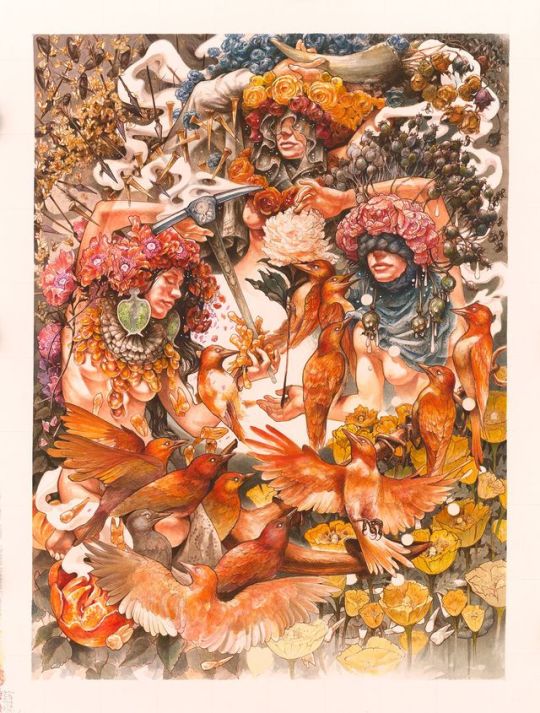
Never before have premonitions been as wary and nerves been as tense going into a new record from the mighty Baroness as they have been for Gold & Grey, the follow-up to the band’s fourth, and my favorite, album Purple, and the proclaimed finish to the band’s saga of color-themed records. And all this tension sprouted up after the release of the album’s first single, “Borderlines”, back in March, stemming from one irritating source: the song’s production. While Purple was a step toward a more compressed and hard-rock-oriented production style after Yellow & Green, the songs were so consistently ridiculously well-composed and powerful enough to outshine the slightly grainier production that the band were kind of able to get away with it. But Baroness really went all in on the over-compressed, fuzzy mixing on “Borderlines”, far more than anything on Purple, to the point of it being a seemingly intentional attempt to give their sound a more lo-fi feel. And this time, with “Borderlines” being one of the most meager lead singles in the band’s entire catalog, the songwriting did not outweigh the atrocious production. John Dyer Baizley sounds like he’s singing into drum microphone fed into a practice amp, the guitars are washed into this hazy white noise of mixing that becomes absolutely atrocious during the song’s finale with the bass all but disappearing into obscurity along the way, and the drums become homogenized and made unnecessarily difficult to discern in all the crackling. And after excitement about new material came and went, fans were not keen at all about this perplexing direction the band were taking behind the soundboard.
The second preliminary single, “Seasons”, was thankfully a much more convincing compositional exhibition that much better captured the soaring emotional bombast that characterized Purple, but the similarly compressed production, though not as bad as “Borderlines”, did not ease fans’ tensions. And Baizley seemed to be in complete denial about Dave Fridmann’s unflattering production job it from what I saw from fan interactions and challenges on the subject.
After finally getting to listen to the album in its entirety, though, I can thankfully say that while the production is still the worst of any Baroness album to date, it’s not as much of a distracting and negating factor as I and many others had initially thought it would likely be. With hindsight being 20/20 and all, “Borderlines” was definitely the worst single they could have led with, suffering more than any other song on the track list from the fuzzy muffling and claustrophobic compression of the mixing. The compression does fluctuate from song to song, thankfully, but it does make attentive, dissective listening more difficult, though not completely impossible, and hearing it in its more tempered doses, I can see what Baizley and company were shooting for with this production style. The mediated fuzz on the tracks more in line with Purple’s level of compression show the type of raw, somewhat old-school feel the band was shooting for, and it does give their sound that kind of vibe here, even if it comes kind of artificially without much compromise on the thickness of the instrumentation they like to use. They certainly didn’t go east on fans though by presenting this mix at its most obnoxious on “Borderlines” before anything else.
Stylistically, Gold & Grey is a continuation of Purple’s refining of the less-sludgy-more-catchy heavy metal sound that started with Yellow & Green, but it is definitely less consistent than its immediate predecessor, and possibly even Yellow & Green too. Gold & Grey has a good few tracks that hit the compositional highs that would help them fit in right at home in style and substance on Purple, the cathartic and expressive “Seasons” being one of them, along with the soaring “Throw Me an Anchor” and the heartbroken “I’m Already Gone”. The triumphant alternative rocking “Tourniquet” even feels like it could fit in with the high points on Yellow & Green. But there are also plenty of tracks like “Front Toward Enemy”, “Broken Halo”, and the low-key closing track, “Pale Sun” that feel more in line with the more average material on Yellow & Green.
The band also try their hand at a handful of more candid clean/acoustic ballads in the middle of the album, starting with the lighter-waving woes of “I’d Do Anything”, moving on to the soft and subtly bell-tinged “Emmett - Radiating Light”, and finishing gloriously with the tenderly gorgeous vocal harmonies between Baizley and Gina Gleason of “Cold-Blooded Angels”.
Though I don’t want to overstate it, this album does come with one other major flaw besides the production. At just over the hour mark with 18 tracks, Gold & Grey is stretched out to its fuller length partly by its littering with numerous and interlude and prelude tracks of questionable value that often seem to stem from incomplete ideas that made it on here only to pad the album and potentially artificially give it a feeling of being more dynamic and diverse than it really is. Again, none of these tracks are absolute bombs; at worst they feel like inert time wasters, but more often they feel like little unfinished musical doodles or like they’re really just part of the tracks they follow or precede.
But honestly, the more I listen to it, the more Gold & Grey’s positive qualities outshine its negatives. The interlude tracks are mostly inoffensive or even just codas or intros, and the production, though grainy and less than ideal for Baroness’ intricate heavy prog rockery, is not as crippling as many, myself included, had anticipated it being. It takes a few listens to get used to (or past), but it’s not as abrasively lo-fi as a Microphones or Neutral Milk Hotel record or anything like that. Though maybe not as wildly dynamic as the band would like you to believe, this is definitely a diverse crop of songs, most of which find the band playing to the strengths they established on Purple or even succeeding with the few first-time accomplishments they set out for on here. Baroness’ knack for bold, slightly sludgy, proggy, alternative metal composition is thankfully still the focal point of the album, and the band members’ powerful performances still manage to break through the muffling screen of the album’s mixing. I wouldn’t say that it supplants Purple from my favorite spot in their discography, but considering how incredible that album is, it might just never happen. regardless, Gold & Grey is a respectable follow-up and affirmation that Baroness still have plenty of artistic potential and creativity to pull from. It feels weird knowing that this is the end to the color-themed albums, but I’m also excited for what Baroness have in store for the future after the possibilities this album has opened up.
sun-bleached art nouveau/10
#Baroness#Gold and Grey#Gold & Grey#progressive metal#sludge metal#alternative metal#progressive rock#metal#heavy metal#new music#new album#album review
6 notes
·
View notes
Text
Business Card Project - Part 1
Around the time this module started, I got back into contact with someone by the name of Josh Hitchcock who I met and worked with back in college. We met when we were 16 and worked on several projects with each other during our year studying photography together, I learned a lot from Josh and we’ve stayed loosely in contact ever since leaving school but haven’t collaborated on anything for around 5 years despite having always had similar interests, styles and aesthetics. Josh is also still pursuing his passions and talents in visual communication and is beginning to build a portfolio with the aim of applying for a BA, just like I was doing this time last year. Alongside getting himself prepared to do a degree, he has been expanding his online presence and slowly establishing a business and brand identity for himself. He reached out to me originally to ask if I could potentially create him a logo that he could use across all of his platforms which he needed fairly quickly as he was building a website, unfortunately I couldn’t meet the turnaround deadline and so he commissioned someone else to do a logo, later reaching out to me again to ask if I might be able to create business cards instead.
Josh had already started sketching out ideas and so he sent me his drawings as a starting point for the design
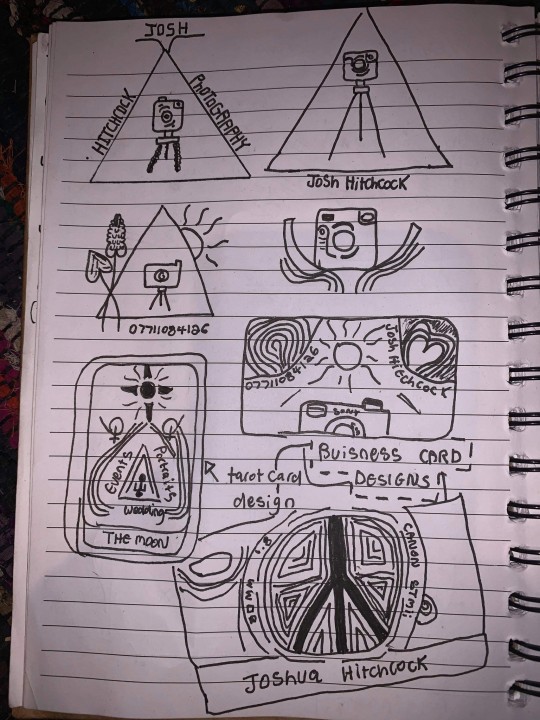
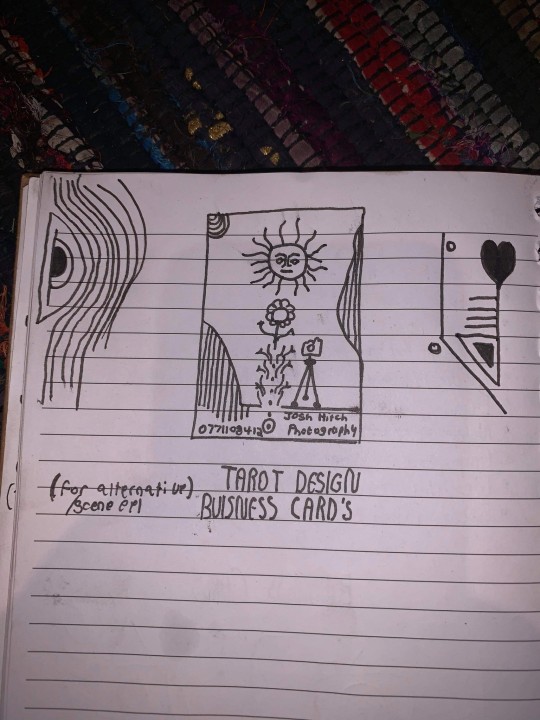
After some discussion and a little bit of time, Josh came to the decision that this was his favorite prospective card design and even began experimenting with it's colors.
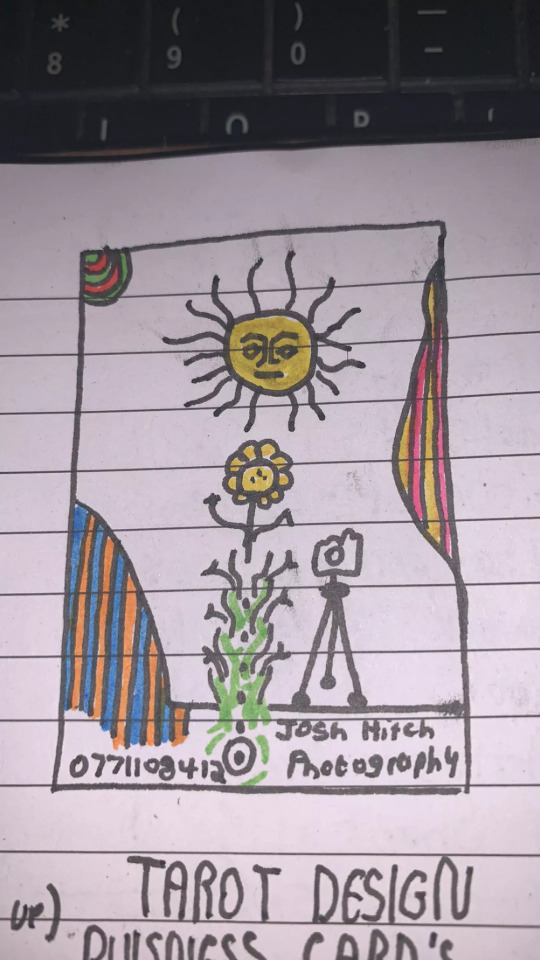
It was at this point that I asked him to create a Pinterest board to help gather all of the ideas together which he promptly delivered on. Pinterest’s description of the board “Clean, simple doodles. Photography orientated based on nature and ancient art. A perfect combination of tech, nature and aesthetic.” sums it up perfectly. This was a really strong starting point for the overall design as it includes everything from small decorative graphic details such as flowers, vines and suns; to a concise range of colors for the palette of the art itself. The board isn’t overcrowded, it's clearly well thought through and does good job of clearly communicating the kind of style that I was expected to reflect in my design.
Coincidentally around the same time I started this project, I decided to treat myself to an iPad Pro and Apple Pencil to support my University work, these have become increasing popular in the art world because they are incredibly powerful creative tools, I chose to invest in it mainly for it’s capabilities in creating digital art using the Adobe suite and Procreate using the pencil which is exclusive to iOS and has is slowly becoming the standard for digital drawings.
Having recently attended the Illustrator workshop, I thought that I would experiment with using this software both on my iPad and computer as I figured if I could learn to use them in conjunction with one another from the get go, I would be in a better position overall later on; but in doing so, I threw myself two learning curves at once as I was not only dabbling in software I wasn’t comfortable with but also using that software on a device that I am a complete beginner to which was a definite challenge for myself.
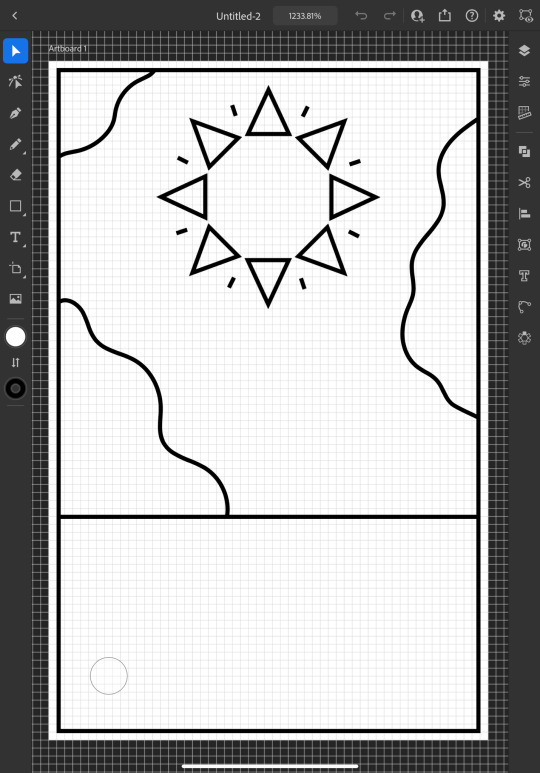
I started out by doing a Google search to find out what the standard size is for business cards and found out that is generally 3.5 x 2 inches (1050 x 600 pixels at 300 DPI, which is the standard DPI for printing). This is how I decided to set my document up which is what gives me the white rectangular shape that you see me working on to start off with.
To begin the design, I picked out my favorite things from Josh's sketch which were the wavy line details and the bohemian style sun. I created some simple outlines using the line tools on iPad Illustrator starting with the border and dividing horizontal line where I intended the design to end, from this I was able rough out where patches of lines would go and add the sun. For the sun, I originally tried to draw one with wavy points but I was struggling to get it proportionate, even when I'd figured out how to use the reflect tool to make my drawing symmetrical, it seemed to be throwing the design off and so I threw this idea out and went for a pointed sun design instead. I chose triangles for the points as a subtle reference to the exposure triangle which is a rule that dictates camera settings when it comes to photography so it ties in with the business well and was also a concept that Josh was trying to reflect in his logo. I achieved the geometrically accurate shape of the points around the sun by creating the very top triangle and then using the Radial Reflect tool whilst using my iPad which automatically created the rest of the points for me with even spacing and perfect symmetry; all I had to do then was resize the points as I pleased. Once I had done this, I decided to repeat the process but with a small line between each point to give it an extra beaming sunshine look, this also fits in with how some of the sun's and graphics are drawn on the Pinterest board that I'm referring to as I design this.
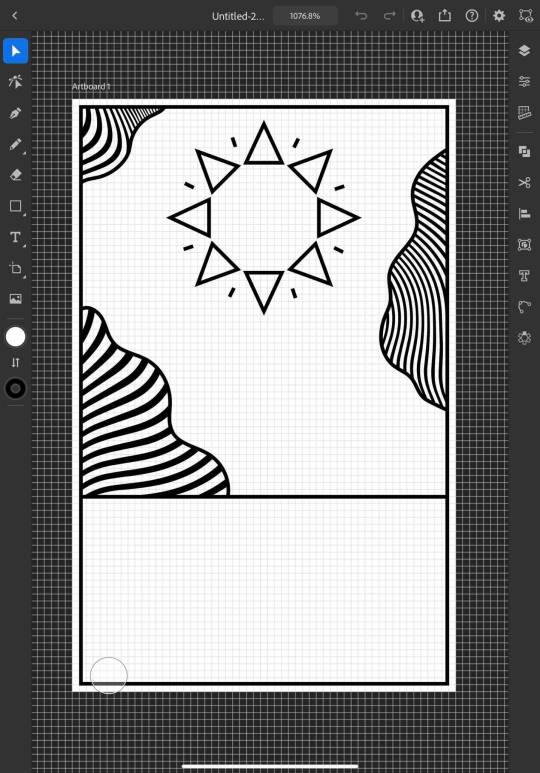
Once the outlines were complete, I started experimenting with filling in the patches with lines, this is an effect that is featured on the album art of one of my favorite albums of all time, Currents by Tame Impala which I previously learned how to do using a vector pack from Spoon Graphics as I did work inspired by it for my University portfolio. Although I have used these particularly line textures before, I have only used them in Photoshop and not Illustrator so I haven't actually used the vector versions of them up until this point. I inserted these into my work using my computer as that's where they were saved, I was able to use Adobe Cloud to sync my work between my PC and iPad making it easy and convenient to switch between the two whilst working. Adjusting the waves worked similarly to how it does when I use them in Photoshop, I just added them in as a layer and then used direct selection mode to delete the extra lines around the outlines and border that I’d drawn in leaving me with what you see above. At this point, I sent what I’d done so far to Josh so that I could begin to get his feedback and make sure that what I was doing was in line with his vision.
Whilst I was waiting for him to reply, I started experimenting with adding color to the design hoping that it would help us visualize it better; I used colors directly from the Pinterest board for my palette by taking a screenshot of the webpage, opening it up in Illustrator, swatching all of the colors and adding them to my Color Library so that they could be easily accessed whenever I needed them.
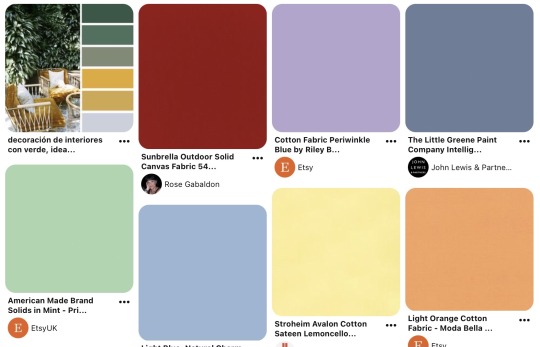
At this point, I just filled in the colors according to what made sense to me, blue for the sky, yellow for the sun and something contrasting for the wavy lines, honestly, I chose orange because it’s my favorite color and I really like the way that the purple looks next to it, especially against the blue background where it appears slightly more subtle whilst still being effective at breaking up the image in the way that it needs to.
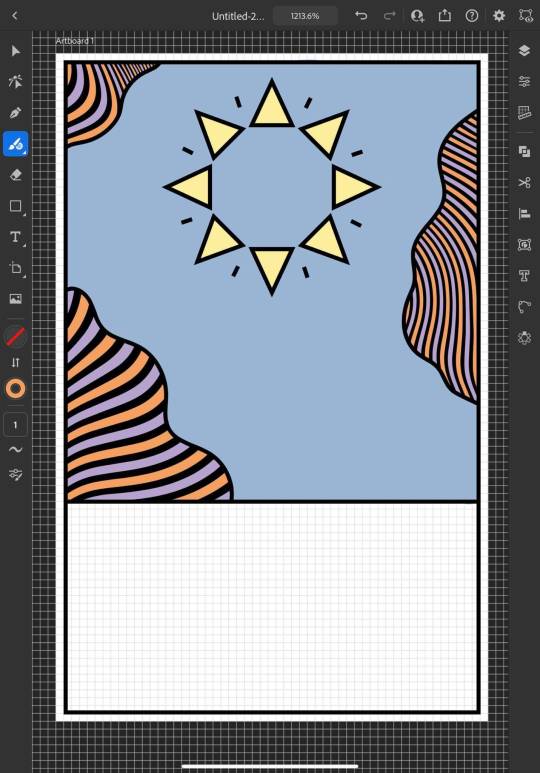
I continued to add colour, changing every other point on the sun to be red to give it more dimension and incorporate more of the colours from the chosen scheme; I then added green to the bottom section which I chose because I thought it would represent grass and fit in with the sun and sky theme that seemed to be emerging. I also added some small stars as I was experimenting with the shape tools dotting them into some small empty spaces on the design so that they line up in a triangular shape which is another subtle reference to the expose triangle.
Then I started experimenting with adding text and social media icons, Josh had told me that he wanted his name, website and social media information on the card, we decided to leave his phone number out as he only has a personal mobile number and didn’t want to risk handing it out to strangers. I chose this Art Deco style font for the name because I liked the lines in it and thought it went well with the lines in the top half of the design which are probably my favourite thing about it at this point. I didn’t use the same font for the website because it doesn’t look as good when it’s small, you can’t really see the lines and it made the website hard to read so instead I chose this glyph font which I thought Josh would like based on some of the imagery from the Pinterest board; I was unsure about this choice at first but it quickly grew on me as it’s subtle and yet it makes the website look bold on the bottom of the image which draws your eye down to it when you’re reading the information. I also added some social shapes to the front keeping Josh updated on my progress as I went along.
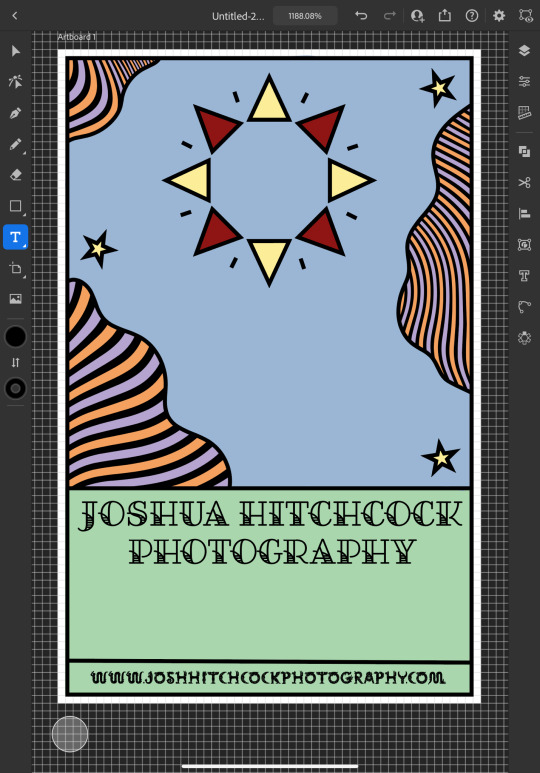
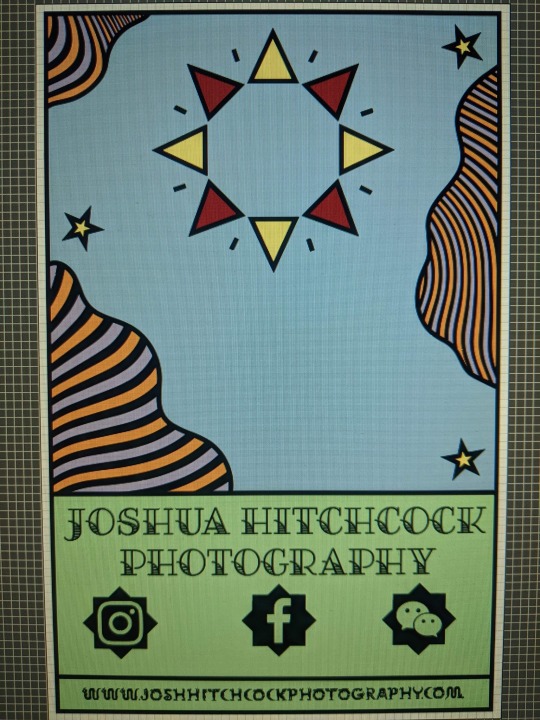
It was at this point that I started to receive some feedback from him, he was really happy with the first impressions of the design but did want to make a few changes. He started out by asking if I could change the green on the bottom to the orange colour in the waves with the hope of giving the card a more uniform look which we both agreed looked much better. He then asked me if I’d started designing the back which I hate to admit that I hadn’t actually thought about at this point and so we started discussing the layout; collectively agreeing to move the social media information to the back of the card and have that there along with some sort of bio which I much preferred the idea of as I wasn’t too keen on how the social shapes looked on the front of the card and I was worried about how I was going to fit all of the contact details on without making it look messy.

Originally we thought it might be nice to add some floral details to the front of the card where the space had now been freed up but we quickly decided that this didn’t look quite right.
0 notes
Link
A skinny, gap-toothed kid gesticulates wildly in the parking lot of Mike’s Drive-In in Oregon City. Short dreads stick up on either side of his head, like antennae to some alien planet. His friends, in the deep background, hang out of a silver Honda, goofing on one another. But it’s nearly impossible to take your eyes off the skinny kid, with his awkward dance moves and urgent facial expressions. He commands your attention. He needs it.
This is the video for Aminé’s persistently catchy “Caroline,” a half-sung, half-rapped summer anthem that went viral in 2016—the video has more than 200 million YouTube views, and the kid front and center is the artist himself. It’s Aminé’s best-known song, and for most music fans both within his home city of Portland and beyond, it represented the MC/singer/director’s colorful first impression.
Aminé—born Adam Amine Daniel, son of Ethiopian and Eritrean immigrants to Portland and a graduate of Benson High—had been around awhile before “Caroline” hit. His debut album, Odyssey to Me, appeared in 2014, though it has long been expunged from the commercial internet. It begins with a low-key prophecy: “I’m headed to my next show / I gotta go / Headed to that Madison Square / 25,000 fans in the air.” Then an accented female voice repeats “Adam, wake up.” It’s Aminé’s mother, coaxing him back to Portland obscurity. But it’s too late. The dream has taken root.
Aminé hasn’t played Madison Square Garden just yet, but he has definitely found a bigger stage. In 2017, the hip-hop magazine XXL included him in its influential Freshman Class, which functions as a sort of critical watchlist of stars in the making. Billboard and the New York Times both weighed in favorably, the latter calling his major-label debut, Good for You, “one of this year’s most intriguing hip-hop albums and also a bold statement of left-field pop.” The album sold 13,000 copies in its first week, debuting at no. 34 on Billboard’s US charts. After a set at Lollapalooza, Daniel posed for photographs with his arm around a new fan, Malia Obama.
Through sheer will and a catchy song, a colorful dream world became Aminé’s reality. From the outside, it’s like he came out of nowhere. That’s intentional. To become the next big thing in the music world of the late 2010s, you have to let the world in on the ground floor. That can sometimes mean recalibrating, or even erasing, your pre-fame history. All the way along, Aminé—who, through manager Justin Lehmann, declined to be interviewed for this piece and did not respond to requests for comment on this story—had boosters and collaborators. Some have come along for the ride. Some were left in the dust. This is the years-long story of Aminé’s overnight success.
Born in 1994, Aminé grew up in Northeast Portland. He’s said his biggest aspiration back then was “to be Kobe Bryant,” a dream dashed when he was cut from the Benson basketball team as a freshman. But he also grew up in a musical environment—he’s told interviewers his parents listened to everything from Ethiopian music to John Mayer—and music eventually became an obsession. In his first recorded performance, he told Vice in August, he rapped about girls and rival high schools over Waka Flocka Flame’s “O Let’s Do It.”
Josh Hickman, a thoughtful and soft-spoken 26-year-old, is three years Aminé’s senior. He also went to Benson and both ran track, but the two barely knew each other then. Three years after high school graduation, as Hickman began his senior year at Portland State University, he connected with Daniel, a PSU freshman, who messaged him about music.
“My first impression of Adam was that he seemed older than he was,” says Hickman, who spent his college years composing and producing rap music under the name Jahosh. “There was a determination, or a focus, that resonated with me. It probably goes back to track and field at Benson. We would work out six days a week. It really instilled me with this work ethic and discipline. So when I met Adam, I was just like, ‘Man this is dope. He’s just like me.’”
I was screaming to the moon, ‘Check out Aminé! He’s doing the thing! Are you guys paying attention?’
Daniel loaned Hickman money to buy a microphone and portable vocal booth, and they began writing and recording on a relentless schedule. “He would come over in the morning and he wouldn’t leave till night,” Hickman says. “But it didn’t even feel like work.” Daniel would give Hickman input on the beats; Hickman says he helped with song concepts and even lyrics. Together they created the first DIY Aminé release, a mixtape called Genuine Thoughts.
With help from PSU music students whom the charismatic Daniel had recruited along the way—including multi-instrumentalist Irvin Mejia, who would go on to produce “Caroline” and other songs on Aminé’s major-label debut—Hickman went on to produce the bulk of Odyssey to Mein his windowless recording studio in East Portland in late 2013. The album’s songs run from vulnerable, confessional slow-burners (“My Emotions”) to explicit sex jams (“Feelin’ Like”). It’s ambitious both sonically and conceptually: The cover art adapts the poster from Richard Ayoade’s 2010 cult film Submarine, about a small-town 15-year-old named Oliver looking to lose his virginity. The album echoes the film’s plot in places, and references its protagonist throughout.
By Odyssey to Me’s 2014 release, Aminé had picked up a few key supporters in Portland, including Fahiym Acuay, an MC and writer (under the name Mac Smiff) for the popular regional hip-hop blog We Out Here. Meeting Aminé for a video interview, Acuay remembers a funny, slightly shy kid who seemed unusually driven. “He knew that he was a little bit different,” Acuay says. “He had a really different sound—kind of playful—but he also had these really deep melodies.” Acuay became an evangelist for the young artist: “I was screaming to the moon, ‘Check out Aminé! He’s doing the thing! Are you guys paying attention?’”
IMAGE: COURTESY MARCUS HYDE AND REPUBLIC RECORDS
While local acts like U-Krew, Five Fingers of Funk, Lifesavas, and Cool Nutz have made some waves, Portland has never spawned a true national hip-hop star. Instead, we have a closed rap ecosystem with its own set of references, stylistic tendencies, and small-town kingpins. Portland rap artists tend to be judged more on their lyricism and verbal ability than on their melodic instincts or pop savvy. And on those fronts, Acuay notes, Aminé is no match for local mainstays like Illmaculate and Rasheed Jamal—battle-tested MCs with dense, intricate rhyme delivery. In fact, if Aminé had emerged a decade earlier, there’s a good chance he’d figure in the Portland hip-hop story as an eccentric side character, selling mixtapes out of his trunk at rap shows. But Aminé was born in a new era, where the home-burned CD has been replaced by lightly curated “mixtape” download websites that connect artists directly to a national audience, with no middleman and no local-cred hurdles to clear.
And Daniel knew how to work that system. He spent $1,000 of his student loan money to secure Odyssey to Me a spot in the featured albums section of Datpiff.com, a popular hip-hop mixtape-sharing blog that has served as a bellwether for artists like Drake and Chance the Rapper. By the end of summer 2014, Odyssey had reached 20,000 downloads. Daniel and Hickman found a promoter to take a punt on them—Ibeth Hernandez, who offered them a show at Peter’s Room in the Roseland, opening for critically acclaimed California hip-hop trio Pac Div. “It was so sweet,” Hernandez remembers of Daniel and Hickman. “They got me a thank-you card afterward, and it had, like, a Starbucks gift card inside.”
But the biggest payoffs came from shows Aminé and Jahosh booked for themselves. A few days after Christmas 2013, they threw a show marking Odyssey’s imminent release, hit social media hard, and drew 250. A party the next year drew 400, among them Blazers star Damian Lillard. His presence alone hinted that Daniel and Hickman had sidestepped most Portland hip-hop rites of passage. Not everybody would be happy about it.
But Daniel was making connections outside of Portland, too. In summer 2014, after landing internships with Complex magazine and Def Jam Records, he connected with a young, unestablished New York City manager named Justin Lehmann. To Hickman, something about the new arrangement set off alarm bells.
“I was with Adam from day one,” he says, “thinking, his success is my success and my success is his success.” Though he won’t dive into specifics—and allows for miscommunications—Hickman says he decided to get his handshake deal with Daniel into writing. Daniel refused. Hickman “got even more weirded out.” The partnership slowly unraveled, taking the pair’s friendship with it, and Hickman would later pull Aminé’s first album and the subsequent En Vogue EP from the internet, asking social media outlets and blogs to do the same. “It was my assumption that he would have most likely taken the music down himself, had I not,” says Hickman.
He was building this full package for himself. He didn’t just focus on Portland.
Aminé’s second full-length album—the excellent, world-music-inspired collection Calling Brio—proved that he was capable of making great music without Hickman. That too has been scrubbed from the web post-“Caroline,” along with videos and articles from 2014 and 2015, as has become standard practice for many indie artists who take on a major-label rebrand. Around the same time, Daniel texted Acuay to ask him to remove all the pieces We Out Here had written about Aminé from the site. Acuay reluctantly agreed. Later, when he saw a national piece on Aminé billed as “the first interview” with the young artist behind “Caroline,” Acuay admits, “I was kind of salty for a second. I had the first interview.”
Two years after Josh Hickman and Adam Daniel parted ways, Aminé struck gold with “Caroline.” The single and video led to a deal with Republic Records, a Universal subsidiary home to artists from Ariana Grande to Black Sabbath. While Daniel moved to Los Angeles in 2016, his official label bio still begins with “Now, Portland isn’t traditionally referred to as a hotbed of hip-hop like Brooklyn or Compton is, but Aminé could very well change that perception.”
For a moment, it appeared that Aminé might force the issue. In November 2016 on Jimmy Fallon’s Tonight Show, Aminé performed a striking and minimal version of “Caroline” with a string section. At the end of the performance, the yellow stage lights switched to red, white, and blue, and he delivered a message to the incoming president elected just days before. “You can never make America great again / All you ever did was make this country hate again.” It was a bold choice, one the Times and other outlets focused on. But Portland music fans noticed something else: two vocalists backing up Aminé were established players in the Portland scene, earthy R&B artist Blossom and inventive MC the Last Artful, Dodgr.
Acuay was watching that night. “It was so very Aminé. ‘I’m not going to do what everyone expects me to do.’ I was really proud of him. I remember thinking, he’s making us look good. He’s really holding it down for Portland right now.”
Publicly, “Go Aminé” is the party line in the Portland hip-hop scene, as well. But there is grumbling behind closed doors. A handful of artists and music scene staples contacted for this story declined to be interviewed about Aminé, or did not respond to requests. One artist formerly associated with Aminé indicated a reluctance to be seen as a hanger-on. A polite decline came from Nikolaus Popp, the prolific Portland director credited as the cinematographer and editor behind the “Caroline” video. Popp sent a somewhat cryptic statement: “Respect is everything in this world and that really goes for any human being. People will try to minimize you, but you always have to know your worth. Money doesn’t pay for respect, no matter the amount. It’s about how you treat people.”
In his first big national profile in the New York Times, Daniel used the phrase “super depressing” to describe his path through the Portland music scene, which the article’s author further characterized as “dead.” Aminé’s lyrical take on Portland has been bittersweet since his earliest songs. And on Good for You, he raps about coming home to find kids who bullied him calling him a hero. In the song “Turf,” he details the city’s gentrification in a mournful chorus: “I look around and I see nothing in my neighborhood / Not satisfied, don’t think I’ll ever wanna stay for good.” Another lyric speaks to those mixed emotions with even more clarity, and perhaps provides an explanation for the artist’s systematic eradication of the old Aminé: “I used to have dreams / Now I dream.”
I asked Vursatyl, one-third of the Portland crew Lifesavas—they released their debut, Spirit in Stone in 2003—if his group experienced a Portland backlash when they surfaced on the national radar. “The difference is we were really trudging it out in the local scene for a long time,” he says. “There were a lot of us trying hard to make it. Some of it was friendly competition, and some wasn’t. But everybody wanted to be the guy to put the city on the map.”
That city—before the gentrification of its North and Northeast quadrants—was a place where the black community was still somewhat centralized, and Aminé’s family home, off NE MLK and Dekum, sat at its heart. “There’s less of a sense of community now,” Vursatyl says. “And I think that, in the long term, Aminé would have benefited from what was the black community still being fully intact. He’s had an awesome journey and he’s doing great, but I feel like there’s a disconnect in terms of local pride in him. And you want that groundswell. You want to play to your base.”
But for Hernandez—who also booked Aminé’s first South by Southwest performance (“The whole showcase fell apart. It was a disaster, actually.”)—the fact that Aminé’s dreams were bigger than his hometown is exactly what made him stand out. “He didn’t make the rounds like other artists, but that’s OK,” she says. “He was building this full package for himself. He didn’t just focus on Portland. A lot of artists put themselves in a box, and that’s cool, but at some point you have to expand. I saw him expand at such an early point, and he’s still expanding.”
Where Aminé is expanding to is an open question. In interviews, he’s low-key and likable—the right mix of confident, humble, and self-deprecating. Critics praised Good for You as “honest” and “carefree.” Its impressive breadth spans from the floaty Frank Ocean-esque Auto-Tune ballad “Hero” to a curious diss track laid out over progressive, minimal electronic music, “STFU.” If anything, the album seems built—albeit on a solid pop-rap foundation—as a showcase for Aminé’s versatility in both sonic approach and personality. He’s a sensitive, brutally honest outcast on the molasses-slow “Sunday,” and a bitter ex-boyfriend on “Wedding Crashers.” Album closer “Beach Boy” spells out the MC’s thoughts on his own mutability: “Who knows what the future holds / I don’t, if the truth be told / They say play it safe, young soul / Fuck that, I’mma take control.”
Two years ago, taking control meant parting ways with Josh Hickman, now studying software development in Los Angeles and making music as a hobby. When he won an $18,000 scholarship for making a tutorial video about sampling, Hickman used a song he built for Aminé as the video’s source material. “I took it as a message from the universe or God that, hey, I got what I needed out of that situation,” he says. He hasn’t spoken to Daniel in years, he says, but he’s not bitter about the experience. “We had all these doubts,” he remembers. “We’d be in the studio just talking, saying, ‘Man, are we crazy?’ And it’s dope to see those doubts were unfounded.”
In October, Aminé posted a new video to YouTube, this time for his playful song “Spice Girl.” It hit one million views in three days. The video features a cameo from a childhood hero, from the first concert he ever attended: the Spice Girls’ Mel B. Like every artifact of Aminé’s newly rebooted career, the video is colorful, cinematic, and dreamlike.
The video also makes obvious what should have been clear all along: Aminé never had Portland dreams. He saw himself, a first-generation American-born citizen living in an unlikely corner of the country, playing Madison Square Garden. He saw himself in the company of stars.
Something familiar about the particular inflection Daniel gave the titular “Caroline” suggests she’s the same character André 3000 sang about 15 years ago, on Outkast’s smash-hit “Roses.” In Aminé’s later song “Veggies,” from his 2017 so-called “debut” album Good for You, he refers to himself as “André’s prodigy.” These tributes to the eccentric vocal genius and fashion icon who got every wedding party in America dancing to “Hey Ya” are rare signposts from an artist who seemed, to most fans, to “come out of nowhere.”
Just one year after he uploaded the “Caroline” video to YouTube, Daniel posted a street-corner selfie to Instagram. On the left, wide-eyed with his mouth forming a stunned “ooh,” is Aminé. On the right, Outkast’s André 3000.
Adam Daniel used to have dreams—now he dreams. And his most compelling characteristic seems to be that he’s living out his fantasies in the public sphere. But dreams, by their nature, are not collaborative. They are personal. One dream lived is always another deferred. It’s been clear from the moment “Caroline” hit YouTube that the skinny, gap-toothed kid in the front was going to stay there. It’s still anybody’s guess whom he’ll take with him.
0 notes
Text
4 best dance schools in Sydney
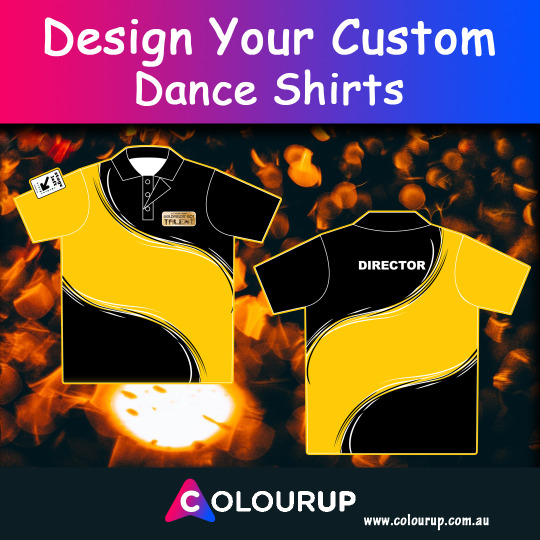
There is no greater form of individual expression than through dance. Whether you need important wedding dance lessons for your big day or just want to rip up the dance floor on a casual weekend, learning to move your body to music is simply a great way to have fun, learn and get some exercise all at the same time.
Needless to say though that not everyone out there is born to move it like Jagger. Perhaps you are a tad uncoordinated, lack the confidence to execute properly or just unsure about how to partake, it can really help the situation to get a bit of advice from a professional before venturing forward with your unique maneuvers.
This leads us nicely to an industry that is one the rise, both internationally and domestically. Dance studios do have quite the overlap with two different and distinct fields – entertainment/the arts and gyms/yoga studios.
The balance between fun, expression and fitness is not lost on those that join in with a friendly and open dance studio, making it a more enjoyable pastime than lifting weights or running on a treadmill; or the pressure that comes with performing in front of an audience.
Many looking in from the outside might know of one or two alternative styles of dance, but the array of options is almost limitless. Deriding from a variety of cultures all across the globe, modern dance studios can teach you everything from:
Mambo
Rumba
Salsa
Zumba
Cha Cha
Ballet
Flamenco
Blues
Jazz
Waltz
Folk Dance
Tango
Breakdancing
Krumping
Twerking
Grinding
Whatever your personal taste or necessity, there will be a dance studio out there for you to cater to this need. For any Sydney locals who are on the search for an open environment that teaches groups and individuals how to get the most out of their dancing moves, check out the following four locations.
Care To Dance
Situated in the heart of Sydney’s Inner West, Care To Dance is the invitation you will have been searching for. Open to appointments and only closed on Sunday, this enterprise is considered an elite boutique dance school that places a priority on a personalised teaching experience.
The majority of visitors usually arrive from one of two different scenarios – either among a social group wanting to bond and socialise over a dance activity, or individual students who will often have an event coming up like a wedding or performance of some description.
Classes and sessions are held for parties from both disciplines, yet Care To Dance will specialise in the following styles:
Ballroom
Disco
Rumba
Tango
Salsa
Waltz
The organisation seeks to give people an added move to their repertoire, allowing them to dance with confidence rather than watching others enjoy all the fun when the music starts.
If their own press does not exactly convince you that Care To Dance is the place to be to receive these helpful tips, then take it from those who have experienced it for themselves.
The glowing 5-star reviews illustrate how well instructors Alexia and Christian go about their work, catering to amateurs that require a great deal of patience, or those that are wanting to fast track their education.
Giving customers a cup of tea or coffee while they wait or have a much warranted break from the slick movement on show, everyone from their late teens to late 70s or 80s have championed the wonderful atmosphere that doesn’t lecture or preach to newcomers.
Issuing 5 stars at Big Review TV, Celeste Poulton has been blown away by her time with the studio:
“My fiancé and I started taking lessons here to build our dancing confidence and have fun together,” she wrote. “We are having the best time! After two lessons we already have so many more steps to use than I thought I’d ever remember. It is so much fun.”
Kylie Davis echoes those sentiments, arguing that the techniques given to the students makes the process all more easy, even without you realising it at the time.
“We love our lessons at Care To Dance. Christian is a great instructor and they have their program really well thought through that breaks down the different dances into segments.”
L.I.K.E. Dance
For those that take their dance a little more seriously than just a hobby or for a one-off event, then L.I.K.E. Dance at St Leonards would be a better option.
Having recently been handed the 2017 Studio of Excellence award at the Rainbow Dance competition, this studio is considered one of the greatest breeding grounds in Sydney for children and adults who are keen on developing their choreography and articulating dance through a mode of storytelling.
Open to studio rental for people or parties that would like the space for their own dancing ventures, L.I.K.E. Dance offers a first up free dance class for newcomers and even performers for hire for those wanting professionals on hand at an event.
This incentive to draw people in clearly works, as their program is open to all manners of styles and disciplines of the craft:
Children classes between 3 and a half years old to 17
Adult classes that range from technical to hip-hop, jazz, modern and contemporary styles
Acrobatics classes
Classical ballet
Competition groups
Wedding Dance
Private classes
The team led by creative director Elena don’t just see dance as a happy past time, but a mode of expression that demonstrates character and emotion. Her team is complimented by some of the most gifted and certified dance teachers in the city, including acrobatics coaches Jackson, Josephina, Lana and choreographer Katerina.
Fees will vary depending on the nature of the class you have selected, but they do offer one month of free classes under the following conditions:
Bring a friend along for an introductory class before they enroll in at least two classes per week, under the explicit understanding that they were introduced by yourself
Spotted only 10 minutes walk from St. Leonards train station, this spacious surround between the Small, Medium and Large Halls are kitted with air conditioning, mats, bars, mirrors and sound equipment to ensure the acoustics elevate the dancing experience.
Dance Central
With a proud history that dates back to 2002, Dance Central is a thriving hub of activity with a legion of great teachers.
From new age styles to the old classical dances, professionals from B Boy Red to Dan Hu, Jean Chritz, Kate Turner Mann, Rosie Cicchitti, Crystal, Yannick, Sam Woods and many more can cater to a variety of cultures and interpretations.
The challenge with Dance Central is not trying to find a dance that suits your needs, but sifting through the sheer weight of options on hand. Essentially every dance genre possible is on the table, including sub-genres that delve into the techniques and meanings behind the movements.
Take any number of these dances as a study, either individually or as a group:
Burlesque
Afro Fusion
Break Dance
High Heels
Jazz
Samba Reggae
Tap
Modern Tango
Hip Hop Beginner/Street Funk
Belly Dancing
French Cancan
Club/Party Dance
Musical Theatre
Jamaican Dancehall
Hawaiian Hula
Contemporary
The studio happens to be an open venue ready to hire for private events, inclusive of Hen’s parties. Dance Central hosts the annual Tour De Dance to showcase their array of talented performers, kicking off in October to put on a show complete with Brazilian Samba, Hip Hop, Burlesque and much more!
Brand new workshops are being developed consistently, such as Loren Robinson’s “Filthy” Hip Hop workshop in recognition of Justin Timberlake’s new album. These workshops are a great method of expressing the teacher’s creativity with new material, something that you will not find across many studios in Sydney.
To sign up to one of these programs, you must have been pre-paid and pre-signed, yet Dance Central is an environment that welcomes first timers to Surry Hills. Recommended to attend at least 5-10 minutes before an open class begins, no bookings are required to get involved.
Crossover Dance
The XO Crossover Dance Studio situated in Sydney is the city’s premiere location for all things dance. Performers from all over the country have congregated to this center to learn, educate and showcase their skills on the dance floor.
There are a number of features that illustrates why this enterprise is on the cutting edge of the industry. For starters, there is an online Crossover App available on Google Play and the App Store for regulars and occasional visitors. This allows a 10-Class Pass for a cut down price of $150 (until April) and is designed around ease of use and speed of access.
Class registration is accelerated through the app and bookings can be made instantaneously. Each consumer who switches their 10-Class Pass onto the app also scores free water.
This modern dance facility is home to variety of dance styles:
XO KPOP
Breaking
Street Dance
House
Popping
LA Style (Urban)
Locking
Hip Hop
Catering different groups of instructors to these respective disciplines, Crossover provides specialty wedding classes that involve the salsa, waltz and various street interpretations for the couple’s big day.
The Asian influence runs throughout the studio, taking inspiration from the culture of the southeast region. Each and every instructor brings their unique interpretation and experience to the center.
As the owner and director of Crossover Dance Studio, Jaye Sutanto is considered one of the true pioneers of Kpop dance in the Western world.
That background translates to the team of teachers and artists he has personally assembled, bringing aboard forward thinking and bold dancers who strive to push the boundaries and discover something new about the industry.
The central objective that Jaye embodies is to provide a studio that is fun and interactive where Sydney locals and outsiders can get involved. His personal profile has amplified after various segments on Google and SBS PopAsia, providing the groundwork to feature at The Sydney Opera House and Sydney Town Hall respectively.
Modern music is a common thread that also happens to run through the studio. From Kpop to Jazz, R&B and House music, this is an ideal environment for teens, 20 and 30-somethings to really tap into their love for music and dance. Although it must be noted that this is not an ageist policy – open to people of any generation.
The location is ideal for commuters traveling by foot, bus or train just minutes away from Central and Town Hall stations.
Once you feel confident in your dancing ability, it’s time to enjoy yourself and reap the rewards of all of your hours of practice! Invite your family or friends out to a dance class, party, bar, or club. Alternatively, you can invite them over to your home for an informal night of dancing and fun.
Make Your Own Custom Dance Uniforms with Colourup Uniforms.
We are the Specialist in all Kind of Custom Dancewear and Uniforms
Our Custom made Dance Polos and Sublimated Dance Jerseys gives you the luxury and durability you need for your dance Performance.
Sleek and stretch resistance are going to give you and your entire team the kind of presence on the field.
Below are some of the categories for you to explore.
Categories:
Design Your Own Custom Dance Apparel
Design Your Own Custom Dance Uniforms
Design Your Own Custom Dance Wears
Design Your Own Custom Mens Dance Polos
Design Your Own Custom Mens Long Sleeve Polos
Design Your Own Custom Mens Dance Jerseys
Design Your Own Custom Mens Long Sleeve Jerseys
Design Your Own Custom Mens Dance Jacket
Design Your Own Custom Mens Dance Singlets
Design Your Own Custom Ladies Dance Polos
Design Your Own Custom Ladies Long Sleeve Polos
Design Your Own Custom Ladies Dance Jerseys
Design Your Own Custom Ladies Long Sleeve Jerseys
Design Your Own Custom Ladies Dance Jacket
Design Your Own Custom Ladies Dance Singlets
Design Your Own Custom Button up sleeved Jerseys
Design Your Own Custom Dance Hoodies
Reference:
https://bestinau.com.au/best-dance-studios-sydney/
#customdanceuniforms#customdancewear#customdanceapparels#customdancejerseys#customdancepolos#customdancehoodies#customdancejackets#customdanceshirts#customdancepants#customdanceshorts#customlongsleevejerseys#customlongsleevepolos
0 notes
Link
Artist: Han Bing
Venue: Antenna Space, Shanghai
Exhibition Title: A Labile Boundary at Best
Date: January 11, 2020 – March 10, 2020
Click here to view slideshow
Full gallery of images, press release and link available after the jump.
Images:
Images courtesy of Antenna Space, Shanghai
Press Release:
Pixelating, Tearing Apart, and Regrouping
I. Spatial relationship has been a continuous thread in Han Bing’s painting practice. In works c. 2013, physical and architectural spaces bear the weight of the artist’s visual expression. In Bush (2013), an outdoor tree is inserted into the interior of a modernist house; Meeting (2013) depicts a domed room converted into a deep dry well; and, in Landscape #5 (2014), a floating billboard of landscape, like the backdrop for a play, is suspended above a pink stage. With these works, Han Bing wanders along the fine line between fiction and nonfiction. She examines and imagines an unusual quotidian reality using painterly thoughts.
In Ball Room (2015), muted depiction of human figures contributes to Han Bing’s exploration of spatial relationships. The crowd in, presumably, tuxedos and gowns appear no different than the crystal chandeliers, stairs, or curtains in the background. Thick layers outline shapes, conveying specific objects and figures; but none of this is the subject of this work. The subject is encapsulated in the three bars of colors – white, gray, and deep red – placed high and centered in the painting. The bars are short and clear-cut, and contrast with the rest of the jagged images that resemble visuals from a distorted television screen. With this work, Han Bing seems to be confronting a contemporary dilemma: In an era during which images and symbols saturate reality, how can a painter trust their authenticity on the canvas? Perhaps, at the time she created this piece, for her, the straight-forward bars of color served as a refined extraction of shapes, but also a basic unit she could trust to measure reality.
II. Han Bing soon started to fight against this dilemma, and fortunately, she was not devoured by this beast-like reality that is so occupied with an excess of images. On the contrary, she strove to identify its chaotic nature and portray the folds and particles within it.
In a group of works represented by East Wave (2017), Han Bing used photos she took of street posters and subway advertisements in various cities. She noticed these ready-made images that had been torn apart in many iterations, and then translated the misplaced, ripped-apart, and then adhered parts onto her canvas. In East Wave, the artist created at least three layers of images: first, a large area of yellow with white-edge slices sits in the foreground, almost appearing as a yellow iceberg; next, a layer of faint blue and red creates a haze, haunting the background behind the bold yellow shards; at the bottom, a plain grayish-white with creases and neat borderline suggests a darker background lurks below the whitish surface. It seems as if the image’s most relevant parts have been sliced off in large chunks. The gaps, holes, and fragments give off the feeling of an abandoned image as an object.
Other works in the series, such as Double Screen (2016) and Overlap (2017), include complex layers of images, dazzling the eye to the extent that it is difficult to clarify the elements. The eye experiences a journey full of rhythms while moving around these images, just like a melody with peaks and valleys – along the white edges lie the staggered residuals of fragmented images; some parts are dense like drum beats, some graffiti sprays a line of rap, and some comet-tail-shapes the ending notes with a gradual-weakening effect. The materialized and invalidated images are reborn on Han Bing’s canvas. She cherishes the previous life of these images, tracing back the process of separation between an image and the information it carried, and keeps the glue marks, curly edges, uneven wrinkles, and torn and broken remains. She replaces the original images to allow a new one to emerge.
For Han Bing, the creation process is an anti-symbolic one. It is also the reality that Han Bing gives to her painting. She deconstructs all sorts of purposeful images in real life, and these resulting images construct new patterns, rather than new semiotics. In the titles of some works, places like New York City’s Mott Street, Canal Street, and Downtown LA are mentioned. They hint at the existence of spatial relationships in a traditional sense. But just as the images are stripped of meaning, the reference to specific locations has nothing to do with geopolitical critiques; rather, the geographical information is an archiving method for the newborn patterns.
III. If it is presumed that Han Bing started off figuratively depicting images and her portrayals of the folds and particles of reality led to abstract images, then we could argue she is taking it one step further: She knows how to comb a chaotic reality and re-purify it in a more abstract way than an abstraction. It is as if she starts the second round of a juice squeezing process by using a spoon or a blunt tool to scrape fibers remaining on the squeezer’s filter. She gets more drips.
She first filters out specific references, thus erasing any portrayal of reality. In I am not unaware of my reputation for self-seriousness (2019), a work based on a broken poster of FKA Twigs’ new album, the singer’s metal earrings could be recognized faintly in the fields of reddish-brown and dark purple. The borders, edges, curls, and wrinkles are all removed. The effects of pixelating and tearing-apart have merged into her recent works, forming a new visual language through their amalgamation.
By banishing the portrayal of reality in her work, Han Bing opens up space in her practice to explore intertwined memories and cultures. Taking Angels in America (2019) as an example, the shape of the angel’s double wings is based on a photo of a miniature sculpture the artist took at the Metropolitan Museum of Art. Its composition recalls Luc Tuymans’ painting Angel (2004), while its title makes direct reference to the eponymous play written by the acclaimed playwright Tony Kushner. Yet, Han Bing’s painting remains anti-symbolic, as the angel in her work does not appear in traditional white, nor does the artist go deep into any of the details of the image of an angel. The artist abstracts the sculpture into two-dimensional outlines on her canvas, as if this is the only way that all three angels – from the Met, Tuymans, and Kushner – could coexist as one.
Such an introduction of memories and cultures may correspond to Han Bing’s growing interests in frescoes. From the fresco fragments, which had been traced back to the Renaissance and had been shaped by the power by time, the artist realizes that, through the centuries, the broken and missing parts of a fresco have all become its flesh – it is as if the fragments have taken on an organic quality – changing with the passing of time. They are the shape of memory and culture in themselves. In the meantime, Han Bing switches her medium from acrylic to oil paint. Compared with the former’s quick-drying lightness, oil paints are thick and tough, an almost “meat-like texture,” as described by the artist. Accordingly, painting becomes a battling process that requires physical wrestling, in which a painter’s hand tames her paint, and vice versa. Again, it is as if the work has its own life that shifts and revises as time and forces act upon it.
Spatial relationships remain an important element in her work, and perhaps even more important than ever. In Cards on Cords (2019), Han Bing restages a scene she captured from a construction site. The interior of a building has returned to the collapsed state where all bricks, steel bars, grids are not functioning at all. The doors have fallen down, the walls peeled off, and the sawdust is scattered around everywhere. It is a scene ten times worse than an abandoned image. Symbols and their carriers, frameworks with structures have all lost use. Adopting a large format canvas with a height of more than two meters, Han Bing positions her viewers right in front of the hole of the ruins. In its upper right corner, the sketchy brushstrokes evoke a feeling of potential danger from falling stones. However, despite the fact that it’s falling apart, the entire scene also inexplicably displays a sense of order, in which pillars stand firm to support vertical structures. It seems that the purpose of the chaos here is not to destroy, but to reveal its inner layers. Like a metaphor, the work combines abstract and figurative visual languages to push the viewers to confront what the artist has seen and felt, as her painting has regrouped those fundamental things that are not taken away by the chaos. One could argue that the spatial relationships manifested in Han Bing’s works mirror our relationship with reality.
Perhaps the artist knows well that ruins are the dead-end of dilemmas. Through pixelation and tearing-apart, Han Bing has developed a process of regrouping, and through painting, she conveys these visual experiences to us.
Written and Translated by Qianfan Gu
Link: Han Bing at Antenna Space
Contemporary Art Daily is produced by Contemporary Art Group, a not-for-profit organization. We rely on our audience to help fund the publication of exhibitions that show up in this RSS feed. Please consider supporting us by making a donation today.
from Contemporary Art Daily http://bit.ly/38wszwQ
0 notes
Text
Where I Work: Alex Daly
New York City-based Alex Daly has been a driving force behind some of the most successful crowdfunding campaigns over the years, including three books from Standards Manual (here, here, and here), Today clock, TLC’s new album, Neil Young’s audio player, and Joan Didion’s documentary, earning herself the much-deserved nickname, Crowdsourceress, and a spot on Forbes 30 Under 30 class of 2016. She is the founder of Vann Alexandra and DalyPR, which eventually morphed into Daly, a company that was spun from crowdfunding clients looking for guidance post-campaign. Now, Daly brings the knowledge learned from running these massive campaigns and offers PR, events, and crowdfunding consultation services. This month’s Where I Work goes behind the scenes to see the colorful offices where Alex Daly does her best work.
What is your typical work style?
Our company, Daly, just relaunched this year as a modern marketing and PR company that offers publicity, crowdfunding, and events services. Before that, I had founded a company that took a soup-to-nuts approach to launching and managing crowdfunding campaigns for designers worldwide. We were very successful, but it was high stakes, 24/7 work and team members were dropping like flies from burn out. Beyond that, our crowdfunding clients were asking for PR after their campaigns ended. Both factors ultimately forced me to rethink our goals, and I realized it was time to pivot.
When we managed crowdfunding campaigns full-time, it was about keeping up with the daily crises; now, our PR and marketing work is about planning ahead and ideating ongoing stories in a diverse, community-driven, untraditional way. This means that the work / life dynamic is inherently more balanced. It’s important to me that my team comes in and works hard, but can also turn off at the end of the day and live their lives. I’ve literally written this into our company handbook, to make sure this is an ingrained and observed part of our company culture.
Overall, our relaunch has allowed us to begin working with clients in a longer term capacity. It’s been a really exciting shift so far—and we are partnering some of the best creators in the world, like Pentagram, Freitag, Standards Manual, and Doberman. It’s a massive privilege to grow and evolve with them.
Personally, I feel like I am always working, and I like that! I get up early and send emails from home; after work, I have drinks or dinners with writers and potential collaborators. On weekends, I am constantly talking to my boyfriend (and frequent collaborator) about creative ideas or ways to make the company better. I meet with people I admire and try to learn from them (with the goal of working with them, too!). I don’t care for vacations, but enjoy traveling frequently to introduce myself to even more people and projects. Working provides me with motivation and direction. It makes me feel good.
What’s your studio/work environment like?
We worked with my brilliant boyfriend Hamish Smyth’s company, Order, to design our new office. While Order typically does branding jobs, they are beginning to offer interior design services.
Hamish and his excellent designer Nicholas Stover planned out the space to work as a beautiful office and showroom, picking out and arranging every single piece of furniture and all the decor––from the signage on the door to how the posters are positioned against the wall and our lamps are angled on our desks. We are such lucky ducks.
How is your space organized/arranged?
The layout of the space lends itself to exhibiting our client’s creations. Right when you walk in there is a cozy area in front of a towering Vitsoe 606 shelf that is efficiently filled with all types of special objects from our clients: Standards Manual books, a Today clock, Anicorn watches, Keap candles, Freitag bags, AIGA Eye on Design magazines, Greenery NYC plants, AstroReality planets, and Duane King’s Pioneer Plaque replicas.
Behind that is a Saarinen Tulip table for client and team meetings, and on the opposite side is our work area, where we spend most of our days. Hamish painted the back wall to match our branding’s dark gray color, and leaned our favorite posters against that wall.
The space has lots of natural light, and we have filled it with color, which represents Daly. We are an upbeat, sunny bunch, and collaborate with bold, exciting companies.
How long have you been in this space? Where did you work before that?
Only since January! Before that we were in Gowanus, Tribeca, and Greenpoint. We have moved around a lot, but are ready to park for awhile.
If you could change something about your workspace, what would it be?
I love the open office layout. It feels collaborative, and I get lonely quickly otherwise. While we have a cool phone booth tucked next to the kitchen for privacy, it’s still not possible to have private meetings, which is the only thing I would probably change. I wish I had some magic powers to conjure up a meeting room when necessary (*witch emoji*).
Is there an office pet?
No, but we love sharing doggy pics (especially Mr. Bubz!) on Slack constantly.
Do you require music in the background? If so, who are some favorites?
Music is a necessity for me, and we have an awesome teenage engineering OD-11 speaker that does the trick. I am obsessed with NYC rock from the early aughts, so there is a lot of Interpol and TV on the Radio, mixed with stuff like Fleetwood Mac, Neil Young, and David Bowie. We are listening to The Strokes right now. Go figure.
How do you record ideas?
Our client and friend Aron Fay is both a wonderful designer and composition notebook obsessive. We kickstarted his elevated version of a composition notebook, comp, and that’s where you can find all my chicken scratch notes.
Do you have an inspiration board? What’s on it right now?
Our inspiration comes from sitting together at the conference table talking through ideas, or discussing things on Slack. We don’t need a bunch of sticky notes all over the place to make things happen––just sayin’.
What is your creative process and/or creative workflow like? Does it change every project or do you keep it the same?
Last year, I brought on a stellar business consultant, Holly Howard, who was instrumental in helping us restructure and relaunch the business. In addition to putting company culture systems into place, we also created an employee handbook and operations manual. The manual documents everything from what we do from receiving new business inquiries to kicking off a new engagement, where we build a master database that houses all our contacts, agendas, call notes, and more. We have been able to take on many more projects because of this level of organization. There is no other way.
What kind of art/design/objects might you have scattered about the space?
Our Vitsoe 606 shelving houses a lot of our clients’ projects. Next to it, against the wall, we have also hung up a bunch of Freitag bags. We like to showcase work from pals of Daly, too, like our friend Aelfie’s rug and pillows.
Are there tools and/or machinery in your space?
Just a bunch of Macs.
What tool(s) do you most enjoy using in the design process?
Luckily, Order does our design work. They use all the typical design tools—pen and paper, Adobe Suite—and newer tools optimized for digital that are emerging, like Figma.
Let’s talk about how you’re wired. Tell us about your tech arsenal/devices.
I really am not tech savvy. I do love my iPhone 7, and use it for music, podcasts, emails, reading. I love the OD-11 speakers—we have some at home too!
What design software do you use, if any, and for what?
Some of us use Adobe InDesign for proposals and presentations. Other than that most of our work is written. Does Apple Mail count!?
Is there a favorite project/piece you’ve worked on?
There are too many to pick a favorite, but I am proud of publishing The Crowdsourceress, which was a massive undertaking to accomplish on a tight timeline while also running a company.
Do you feel like you’ve “made it”? What has made you feel like you’ve become successful? At what moment/circumstances? Or what will it take to get there?
I don’t know if I will ever feel like I have “made it”––and that’s what compels me to get up and keep working every single day. I do know that I wouldn’t be here without key people in my life: Hamish, my parents, my business consultant Holly, my team, my clients, and my therapist. It really does take a village.
Tell us about a current project you’re working on. What was the inspiration behind it?
Our clients energize us every day.
We are currently working with a women-operated vanilla company, Heilala, that employs and empowers hundreds of women workers to cultivate the world’s most awarded vanilla, grown on the Vava’u islands of the Kingdom of Tonga. Amazing, right?
We also just began working with Pentagram in New York, which is an absolute dream.
What’s on your desk right now?
Some of our beautiful Daly pens. Otherwise, it’s nice and clean. Having a clean and organized office is incredibly important to me; so at the end of the day, all desks and surfaces are cleared. It makes for a clear head!
Do you have anything in your home that you’ve designed/created?
I am not a “creative,” even though I always wished I was. I compromised this desire by working to bring creators’ ideas to life, and promoting the shit out of them. (I do enjoy writing though! Can you tell?)
It makes sense that I live with a highly creative individual, and I am inspired by how he can sit down and actually make something. When we moved into our new home we had a bunch of empty walls, so he began painting. I am so jealous!
Photos by Julia Hembree.
via http://design-milk.com/
from WordPress https://connorrenwickblog.wordpress.com/2019/06/03/where-i-work-alex-daly/
0 notes
Text
How Prince Taught Me About Female Sexuality
New Post has been published on https://kidsviral.info/how-prince-taught-me-about-female-sexuality/
How Prince Taught Me About Female Sexuality
He helped me realize there are men who enjoy being submissive to women — and that being a woman who’s more sexually experienced than a man isn’t something to hide or being ashamed of.
View this image ›
CROLLALANZA /REX USA
As a little kid in the early 1980s, I remember watching the video for Prince’s “I Wanna Be Your Lover” for the first time, as I experienced the magic of cable television and MTV in my family’s first house. I could not look away from this man with the hairy chest, single hoop earring, and feathered hair. When I was around 11 or 12, my sister was in college and dated a guy who was a huge Prince fan. He let me listen to his records, including the B-sides and bootlegs, like “Girl,” “Erotic City,” and “17 Days.” I felt like I was a member of a club with select membership.
I’ve been fascinated with sex since an early age, and even as a child, I knew Prince was “nasty,” but it drew me to him even more. Prince built a reputation on his risqué songs, like “Head” with lyrics that said, “I know you’re good, girl/ I think you like to go down.” With songs like “Soft and Wet,” it’s easy to think that Prince only sees women as objects made for sexual pleasure, but looking further, his songs show women with the same sexual urges as men. Acts like Salt-N-Pepa and Madonna were equally important in showcasing women’s desires through song during my childhood, but Prince’s work resonated more with me. His music shaped my own sexuality because it helped me realize there are men who enjoy being submissive to women, that there are men who are willing to admit to helplessness during sex, and that being a woman who’s more sexually experienced than a man isn’t something to hide or being ashamed of.
His ’80s catalog, in particular, was a revelatory mix of sex, politics, and religion. He sang as a man unafraid of changing how society looked at masculinity, a man who enjoyed a more sexually experienced woman, and as a man willing to follow a woman’s lead.
“Darling Nikki,” from the 1984 Purple Rain soundtrack, details a one-night stand. It has all the markers to offend — a sex fiend of a woman masturbating in public who abandons her conquest after using him. On the surface, the song has much in common with 1982’s “Little Red Corvette,” another song about a one-night stand with a promiscuous woman. However, in “Little Red Corvette,” Prince’s persona warns the woman against her sexually adventurous lifestyle and attempts to “tame” her into monogamy. In “Darling Nikki,” the object of the woman’s affection has no problems with being used and ends the song begging for her to come back. Also, “Darling Nikki” was the catalyst for Tipper Gore, ex-wife of former Vice President Al Gore, to become co-founder of the Parents Music Resource Center, which led to “Parental Advisory” stickers on music deemed too explicit for children.
People frequently sing “Darling Nikki” to me because of my nickname (although I spell it differently) and love for Prince, but they don’t realize how empowering the song was for me once I became sexually active as a teenager. As I matured, I frequently warred with the idea of being a “good girl” who doesn’t talk about sex openly because it meant I was “easy” and yet wanting to express myself sexually in an open and honest way. I was warned that when women talk about sex, no matter how innocently, it makes people want to have sex with her, and that could have dangerous consequences. Even though “Darling Nikki” is told from the point of view of her conquest, I felt drawn to the woman in the title, bold and memorable. I wanted to be like her. I haven’t followed Darling Nikki’s exact footsteps, and my journey to realizing my full sexual self hasn’t always been straightforward, but I often think of her and the song when challenging myself sexually.
Beyond fast-paced rock and pop songs like “Darling Nikki,” “Little Red Corvette,” or even “Raspberry Beret,” where Prince sings about succumbing to the wiles of women more sexually experienced, he has more traditional R&B-like ballads, making sexual demands of his lovers for their mutual satisfaction. In “Do Me, Baby” from 1981’s Controversy and “Scandalous” from the 1989 Batman soundtrack, he asks to be touched and explored and lets the objects of his desire know that he’s at their mercy. Despite the persona’s obvious eagerness to make love, he lets his partners set the pace. In “Do Me, Baby,” he waits for his lover to lay him down, a sure sign of the other’s readiness. In “Scandalous,” Prince croons, “Anything’s acceptable / just ask me / and I’ll try it.” He’s willing to follow someone else’s lead. In these songs, Prince sings of his overwhelming desire for his partner but doesn’t rush the rendezvous. He encourages his lovers to lead, knowing that his being in a submissive position will be mutually beneficial.
Video available at: http://youtube.com/watch?v=eu9qkMPr10I.
When people jokingly wonder how a man who wears heels and makeup, challenging ideas of masculinity, is able to date so many women, I often think of songs like “Do Me, Baby” and “Scandalous.” He understands the need to give his partners room to take charge and how doing so doesn’t equal a threat to his manhood. On the album version of “Do Me, Baby,” Prince ends the song with his orgasm, begs his partner for help, and finally asks to be held. The vulnerability he displays perhaps answers the question of how this diminutive man in eyeliner and lace can be considered a ladies’ man. It set a high bar for me when it came to my own sexual partners. I expected my boyfriends to let me lead sometimes and to express neediness without shame. My disappointment was frequent, so I’d return to Prince’s music to daydream.
As much as Prince’s music gave me permission to accept my own sexual maturity, his discography is not without issue. Sometimes he is flat-out hypocritical and misogynistic. “Little Red Corvette” borders on what we’d now call slut-shaming. On stage, Prince frequently pairs women dancers together in sexual mimicry, and yet some of his lyrics scold women about being bisexual. On the 1979 self-titled album, the song “Bambi” attempts to convince a woman to abandon her female lover because “it’s better with a man.” Prince ends the song declaring, “Bambi, I know what U need / Bambi, maybe U need 2 bleed.” In the 1982 bootleg single “Xtraloveable,” Prince’s persona tries to seduce a woman by asking her if she wants to take a bath with him. He praises her because she doesn’t brag about her love life and doesn’t appear to be loose with her affections: “What I dig the most is the way that U keep your sugar in your hand / till I want it.” However, later he claims he’s “on the verge of rape” then: “I’m sorry / but I’m just gonna have 2 rape U / Now are U going to get in the tub / Or do I have 2 drag U?” Prince moves from seduction to rape, and it’s jarring. Here, his usual submissive role is gone and replaced with an overly aggressive one. One moment, the song’s persona is happy that his lover makes him wait, and the next he’s threatening rape because she doesn’t respond to his advances quickly enough.
Prince recently performed “Bambi” on Late Night With Jimmy Fallon with the all-female band he fronts, 3rdEyeGirl. He didn’t sing the final threat of violence, but the overall sexist sentiment of the song remained, especially considering the fact that Prince stood in front of an all-woman band. Perhaps Prince decided to play the song because it’s more rock than funk or R&B and showcases his rock guitar talents. It remains an odd song selection.
In 2013, Prince released “Extraloveable Reloaded,” with sanitized lyrics. The sugar in hand becomes a vague “it,” and any mention of rape is scrubbed. Since Prince became a Jehovah’s Witness in 2001, he’s become increasingly conservative, refusing to play most of his racier songs that cemented his place in pop culture. Recent music like “Da Bourgeoisie” returns to shaming a woman for her bisexuality, but “Breakfast Can Wait” hints that the old, raunchy Prince is still around.
Video available at: http://youtube.com/watch?v=GHbyNrGXpAA.
Prince still has moments where he wags his finger at a woman because of her choices, but then I think of “If I Was Your Girlfriend,” from the 1987 album Sign O’ the Times. It’s a song so important to me that I have a line of its lyrics tattooed around my left ankle. In it, Prince’s alter ego Camille sings in the perspective of a man who wonders if becoming a woman would lead to a closer relationship with his current female lover. Again, Prince disrupts heteronormative ideals of masculinity by being willing to change genders for more significant connection, the kind shared between women.
It’s hard to reconcile the Prince of gender-fluidity with the one who refuses to comment on same-sex marriage. I’ve overlooked his bouts of hypocrisy and sexism to concentrate on what I’ve learned from his music over the years. With his music, I gave myself permission to be bold and shameless in my desires. As a Southern woman, I’ve grown up dancing to a lot of music that directly contradicts my feminist beliefs, like bass and bounce. Lyrics demanding women to pop their pussies or guaranteeing material goods in exchange for satisfactory sex fly directly in the face of the idea that a woman is more than her body and sexuality. It’s not enough to shrug off the misogynistic verses simply because of a good beat. Not only did I give myself permission to speak freely about sex, I also had to allow myself to be a complex person who enjoys flawed artists and their art.
Prince’s early catalog taught me things about myself I wasn’t even aware I was learning at such a young age. When I made the decision to become sexually active as a teen, I imitated Prince’s moans and gasps from his songs as practice to make sure I would sound sexy in bed. To this day, you might catch me making sounds straight from “Do Me, Baby,” “Girl,” or “Vibrator,” a Vanity 6 song Prince wrote. That’s what was sexy to me — a man willing to vocalize pleasure and be vulnerable and so I sought to translate that into my own sex life. Despite his increasingly conservative beliefs and his occasionally sexist lyrics, Prince helped me achieve an honest and good sex life. For that, I’ll always be grateful.
Read more: http://www.buzzfeed.com/tnwhiskeywoman/do-me-baby
0 notes
Text
Trixie Mattel Sounds Off On Shocking 'RuPaul's Drag Race All Stars' Win
http://fashion-trendin.com/trixie-mattel-sounds-off-on-shocking-rupauls-drag-race-all-stars-win/
Trixie Mattel Sounds Off On Shocking 'RuPaul's Drag Race All Stars' Win
Trixie Mattel already snatched hearts and wigs as the lovable underdog turned internet sensation, and now she’s snatched the trophy, becoming the third queen to be crowned on “RuPaul’s Drag Race All Stars” on Thursday night.
The reality competition series has produced a roster of megawatt stars since it premiered nearly a decade ago, but with her blend of self-deprecation and life-sized doll aesthetics, Mattel is also one of the most successful: She’s now topping iTunes charts with her folk music album “One Stone” and stars on Vice’s weekly “The Trixie and Katya Show.”
The 28-year-old performer might have the best post-“Drag Race” track record around, but her journey on “All Stars” Season 3 hasn’t been without its ups and downs.
After front-runner BenDeLaCreme removed herself from the race mere episodes shy from the finale, the crown was anyone’s for the taking. When a jury of the eliminated queens decided the fates of the final two, unexpectedly striking out the fan favorite Shangela and first season queen Bebe Zahara Benet, Mattel went on to best fellow Season 7 queen Kennedy Davenport in a powerhouse final lip-sync to Miley Cyrus’ “Wrecking Ball.”
Both Mattel and Davenport struggled at points during the competition, unlike the previous season’s winner, Alaska Thunderfuck, who was pegged to slay the game before the first episode even aired. Mattel’s win arrives at a time when the “Drag Race” plates are shifting, as its legion of fans are questioning if the twists-for-twists-sake format is robbing some of the most talented queens of a victory. She’s also the third white drag queen ― Mattel is half Native American but refers to herself as a “boring white dude” ― to enter into the hall of fame, causing an uproar after the episode aired on social media.
We caught up with Mattel after her win and, oh, honey, did she spill about everything, including her post-“All Stars” plans, the reception to the finale and what she plans to do with the prize money.
Your journey on “Drag Race” has been tumultuous in the best way, and it feels long overdue for you to go out on a high note. Did you ever expect to be an all star, and what’s your headspace like after the finale?
I’ve always played the game in my career as if this will never happen. I’m happy it happened, but I definitely didn’t ever count on it or bank on it. Both times previously I lost on “Drag Race,” so I’ve only been a winner for like 12 hours. I think if you’re a real all star, you go out and you’re an all star whether or not you never do “Drag Race” again. I envision myself quitting drag some day and being able to say I won the Olympics of drag. That’s cool, but you can be a really strong athlete and not necessarily win the Olympics. I hate to say I feel almost the same, but I just feel really lucky. Shangela, Bebe and Kennedy were so good, and it literally could’ve been any of us.
“The Trixie & Katya Show” is already a success, and your album is topping the charts. What’s next for you?
Well, I’m currently nominated for a James Beard Foundation Award, a major culinary arts award, which is hilarious, so I would like to win this major food award. My album came out yesterday, and I hope people hear it and love it. I’m doing 40-plus cities of a United States tour of my show “Moving Parts,” so people will be able to come see me play my guitar and tell jokes in real life. I’ll be writing a new show this summer. The wheels keep turning. “Drag Race” is really cool, but I’ve always got the next 10 monopoly moves ready.
Do you feel like you need to defend your success in the competition given that some of the top competitors were knocked out of the race before the final lip-sync?
The people who should have to defend that are the people who pulled the lipsticks, you know what I mean? You saw me in the interview. I really thought Shangela and I were going to be lip-syncing, so I was as shocked as anybody else. I have huge respect for her, and I think she’s such a superstar given her track record. I’m an optimistic realist. I kind of expect the worst but prepare for the best.
There have been conversations about the rules of “Drag Race” and how the endless twists are negatively impacting the show. As a competitor but also a major fan, do you think the show should return to the strict merit-based elimination criteria?
I don’t think so. As much as people might not always agree with the choices made, it’s fun to watch. On a normal season, when people are in the bottom and there’s a lip-sync for your life, people also often disagree about who wins the lip-sync. When they announced that the people choosing were going to be judges, in a certain light maybe that’s more fair because these people were in the workroom and behind the scenes at all times. Who better to make the call than people who were in the Snatch Game with you or learning the choreography next to you? They know how hard everything was, and they know who struggled. In a weird way, they have a lot of insight the judges can’t offer.
You turned a corner about halfway through the competition. What was that like to embrace your creativity after being in the bottom and go for broke the rest of the season?
Once I was in the bottom and Shangela had basically psychologically cat-and-moused me emotionally and spiritually, I had already accepted that I was going home. When I didn’t, it was kind of like when they pull the mask off the killer. I was like, “Oh, this isn’t a ghost. This is ‘Scooby Doo,’ and this is a janitor.” I kind of realized if I lose it doesn’t make me a bad drag queen, and that’s something I’ve always believed anyway.
The fear of losing and the fear of disappointing kind of completely left. I just made bold choices, and that’s it. I was only in the bottom really for Snatch Game, so it was just really one day when I had a bad trip-up. The only other time I was in the bottom was when if you weren’t in the top you were in the bottom. The narrative a little bit was like you haven’t been here or where’s your brain, but I did great in every challenge, and I just fucked up today. But I don’t even think the TV did it justice. I literally probably did the worst Snatch Game in the universe.
You are one of the most active queens on social media and engage with conversations about “Drag Race,” which I think have tapped into some very key elements of the show’s legacy. Did you see hashtags like #AllStarsSoWhite, and what’s your reaction to the frustration about a third white queen being crowned an all star?
I didn’t even see it. I’ve been avoiding [social media]. I’ll post pictures and videos of myself playing guitar in my room, but I don’t interact or weigh in on topics. As you can see when Shangela confronted me about that note, I can’t really handle confrontation or drama well because I’m never in it, so I don’t really know how to handle it when it comes.
I’ve known this day was coming and I’ve known who was in the Top 2. I watched Shangela in the competition, so I knew that it was going to be a surprise. I was watching yesterday, and her heartbreak was obviously upsetting. Watching Bebe have to walk to the back of the stage was upsetting. The Top 4 was three people of color and I’m only, like, half white. Me and Kennedy were the two people in the room that had the least power. We didn’t pull lipsticks. All we did was lip-sync to a beautiful song by Miley Cyrus.
What’s the first thing you bought with the prize money?
I’m white trash garbage who came from nothing and afraid of living in a car eating cat food at any moment, so I’m just going to save all the money. I know it’s not exciting. I might buy a Nintendo Switch. I live in reality and I know at any moment I could stop getting the phone calls and nobody wants to hear me sing or tell jokes anymore. I just save it all so that one day if I quit drag I have a beautiful nest egg to show for it.
Has Katya reached out to you after your win? What was her reaction to her co-host being an official all star?
I haven’t talked to her yet. I’m sure she’s happy. I’m not sure she’s really watching the show right now. I think her journey of health and wellness probably doesn’t leave her a lot of time to watch “Drag Race.” I’m sure whenever she sees it she’ll live. That was my comfort. I was, like, if I lose we are just a couple of losers like the “Wayne’s World” of “Drag Race.” But now I won, so I can look down on her forever. That’s fun.
Season 10 starts next week. What advice do you have for the incoming queens?
I would say the real race is after “Drag Race.” People like Shangela and I are living proof that you don’t need to have that crown to go be America’s Next Drag Superstar. If they don’t live for your fantasy, you can just go live for your own fantasy.
This interview was been edited and condensed for clarity.
0 notes
Text
Slum Sociable Interview
Edward Quinn & Miller Upchurch
Photo by Mclean Stephenson
Behind the buzz and mystique of Slum Sociable are long-term friends Edward Quinn and Miller Upchurch. Creating subversive and dazzling music steeped in groove, the duo’s arrangements bring to mind a hypnotic sway through the intersection of a variety of genres. Slum Sociable makes catchy music born in Melbourne with truly global appeal. There’s no blueprint to their sound, just many elements – part jazz, part hip-hop, part trip-hop, part acoustic electronica – all cut up and bent into something unique to its Melbourne setting. With a string of sold-out dates and impressive festival performances to coincide with their upcoming album, Slum Sociable are set to defiantly go about their business with a jovial and ambitious outlook… We talk to Miller Upchurch about old habits, motivational speech videos and the NBA…
TSH: Talk us through the significant factors that you felt compelled to cover with your self-titled album…
Miller: I think our upcoming album is significant because it’s an untouched reflection of personal relationships; it’s a bold way of expressing your struggles without burying it in language. It doesn’t need anyone’s acceptance, it just needs to be put out there for the people who need it, and it shows that your relationships can make you feel either side of the emotional spectrum, either really good or really shit, and that it all comes back to you and how you let others affect you.
TSH: Knowing the album was recorded between Melbourne and London, what kind of effect do you feel this had on the overall sound?
Miller: Although we did do some recording in London, for me, personally, the record will always be linked to Melbourne. We’ve lived here our whole life, and whilst the allure of going overseas to record was definitely there, I think what we created with the help of the wizard Russell Fawcus in our city is pretty special. We’ve got a lot of love for Melbourne, so to be able to record our debut album here was really quite cogent and important for us.
TSH: Was it therapeutic to include a reflection of old habits throughout this release?
Miller: Yeah, well, sometimes certain old habits can be hard to write about, but in the end it’s always liberating to speak about your past and learn from it! So I definitely think that having written songs about being treated poorly in the past has made me personally more aware of when I am being treated poorly these days, and when to tell those people what the F is up!
TSH: Was it quite a task to go from having 20 tracks to choose from and cutting down to 10?
Miller: I think the most invigorating and enjoyable part of the process of being a musician is the writing, and we tend to do that a lot. So culling down a list of 20 down to 10 was, in a sense, difficult. But we’re pretty aware of becoming too attached to songs in their demo format, and kind of combat that by writing as many songs as we can. So I guess there weren’t any really tough decisions regarding song selection. There’s also the possibility of those culled songs ending up on other releases too.
TSH: How do you feel your creative partnership has evolved since the last release?
Miller: I think that we trust our partnership’s judgement a lot more now. If we think something is a good idea, that alone should vindicate exploring it and seeing where it ends up. This can apply to music, art direction, collaborations, remixes etc. I think we’ve realised that no one is more qualified than we are to take this project in certain directions. We’ve got a great label and management around us who support us immensely, so not being hesitant to call them and talk shit for an hour about how we want to do things is an element that we’ve learned with time.
TSH: What was the general dynamic like as ‘Castle’ was being formed?
Miller: Well, we were on our first UK/European tour and absolutely gobsmacked that music we’d made in our bedroom had got us this far. We were working with Richard Cooper in his London studio and were riding this wave of adrenaline. I think the day we wrote the bulk of it, we were playing our first show in London that night, so we were extremely busy, but we couldn’t have been happier.
TSH: Furthermore, what sort of sentiment does a track like ‘Hand It Over’ carry to you?
Miller: From the sound of it, it’s arguably the funkiest (sexiest) track on the album, but the lyrics are about missing someone even though they might not be the best person to be attached to.
TSH: Do you still prefer a nice drum groove alongside a bass riff or keyboard pads to inform your starting point for a track, as opposed to guitars?
Miller: Yeah, I think during the writing of this album that was certainly our mentality. I just find that a more exciting process than sitting down with a guitar and busting out chord progressions that I know I’ve done in one shape or another previously. I don’t think there are any right or wrong ways, you just need to find a way to get yourself motivated to write and explore, and if that’s a drum groove or bass line, then so be it.
TSH: As you guys are constantly trying to push your own limits, do you feel the only pressure you put yourselves is purely personal?
Miller: Yes, I think so. We have certain goals that we’ve talked about and want to achieve in the future, but there’s also a sense of some things being out of our control In terms of how an album’s received. We’ve put everything we had into this record, and I think that will translate when people hear it.
TSH: What often piques your interest most on your touring travels?
Miller: We’re not massive fans of really touristy stuff. I’m not saying this to be some kind of ‘underground tourist’ or whatever, but like, famous landmarks and stuff don’t really get me going unless I have some personal connection to them. I think just meeting locals and seeing where they hang out and buy records and party and stuff is what really piques our interest. I remember I had a really fun night in Nijmegen with our tour promoter after our show, just walking through the streets and finding out a little about the town’s history.
TSH: What’s downtime like for you both, outside of music?
Miller: I guess the general stuff like hanging out with friends and family, binge watching TV shows etc. To be honest, we enjoy writing music a lot, so that’s kind of considered downtime to us. (Is that sad?)
TSH: What gets viewed most on your YouTube binges?
Miller: Anything to do with Tim and Eric will usually work, NBA conspiracies too. Or like, motivational speech videos? Those things are fucking hilarious. Shout out to Eddie Pinero.
TSH: How important is it for you guys to also bring to light issues such as mental health and depression?
Miller: It’s something I’ve wanted to talk about on a scale like this for a long time. I’ve always wanted to shed light on an issue that throughout my life hasn’t been discussed as much as I needed it to be, and I just hope that my speaking about it, it brings a sense of relief to people who feel the same. To me, it’s incredibly important because if I saw someone speaking so openly about something that affected me so heavily, it could make an isolated day feel a little less isolated.
TSH: Being huge NBA fans, talk us through some of your favourite players over the last few years…
Miller: Where do we begin? Kevin Garnett was the first player I was ever obsessed with. That was like the purest form of fandom I’ve ever had. And especially because in 2001 there were no NBA highlight videos on the internet, so I had to borrow a VHS from the local library with his rookie season highlights and then try and emulate his moves in my front yard against my brother. KG will always be my favourite player of all time. Special mentions must go to Penny Hardaway, Celtics Rondo, Baron Davis, and Hoodie Melo!
TSH: Finally, what is the best advice that you adhere to?
Miller: Don’t let anyone determine how you define success.
Slum Sociable - “Castle”
Slum Sociable - Slum Sociable
0 notes